Welcome
There are certain cities in the world that you can visit again and again.
For me, London, Florence, Barcelona and Paris.
Eventually I will do special editions on all of them, but this month we are in Paris.
This week I’ll be showing you the Top 5 things to do and see.
Most of you will know about them but sticking to my ‘history’ bent, I’ll help you dive into the history of the place, or the things in it.
Each of the Top 5 could have a whole edition on its own! It has been very hard to limit the number of works of art from the museums, or the photos we have taken on our visits.
This was my 5th visit to Paris, and I think I will have many more in the years to come.
Grab a coffee (or tea) and sit back to enjoy, this my largest edition to date of this week’s Traveling Through History.
Michelle
Savvy Travel Historian.
ps: I know many of you enjoy my newsletter, can I ask a favour? Could you help me build my audience by sharing it with people you think might be interested?? Use the link below. Thanks!
Paris Top 5
Without doubt, there are a couple of places you MUST see when in Paris. I’ve gone for a Top 5, which will only scratch the surface, even though this is my biggest edition to date!
1. The Eiffel Tower

No trip to Paris could be complete without not just seeing but venturing to the top of the 330m Eiffel Tower on the Champ de Mars.
The Eiffel Tower was created by the engineering firm headed by Gustave Eiffel (after whom it is named) for the 1889 world fair to be held in Paris from May to October of that year. The exhibition was to be held to celebrate the 100th anniversary of the storming of the Bastille.
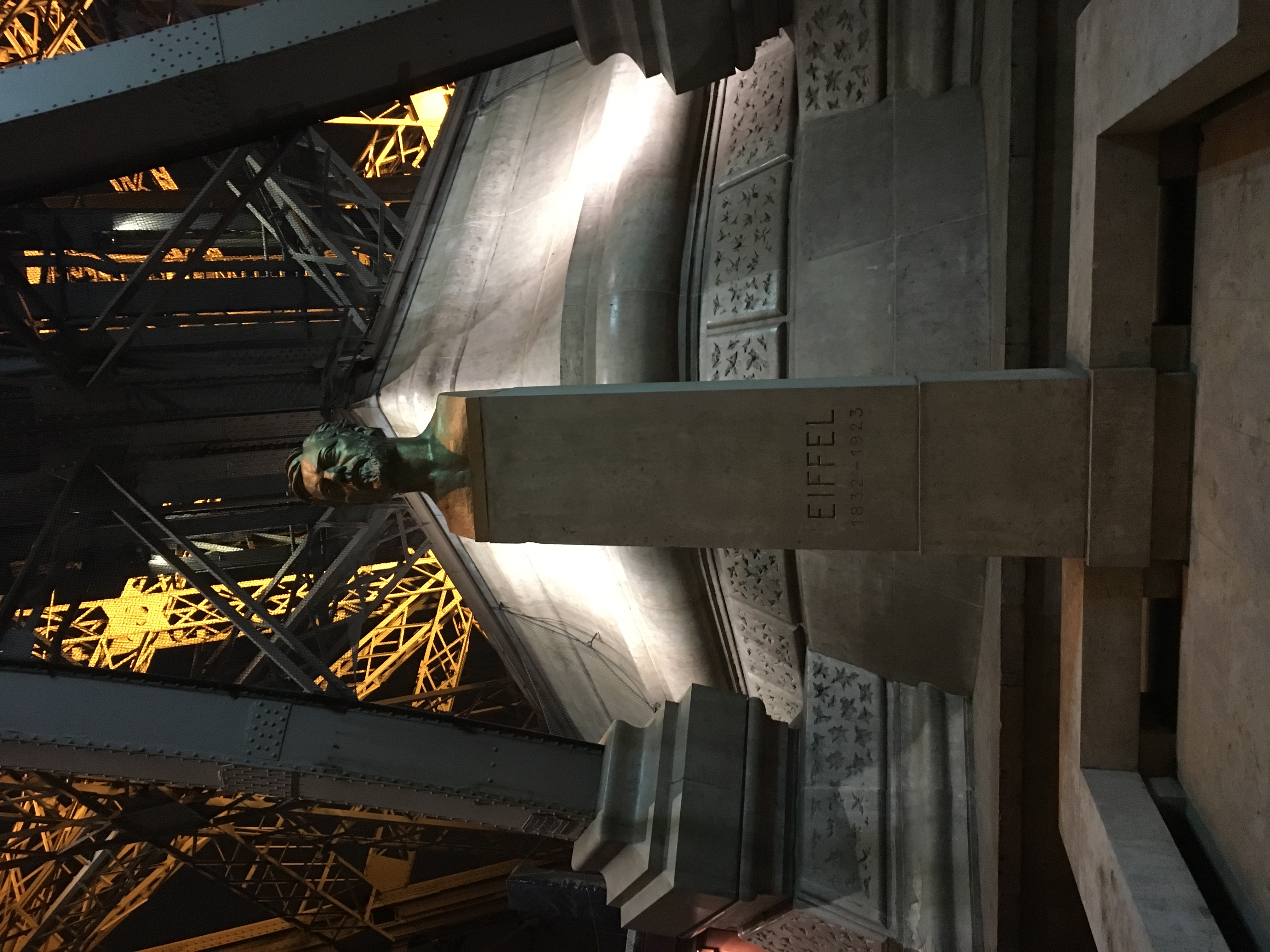
I am often asked if it’s worth paying the extra to go to the top from the 2nd floor viewing area and the answer is a resounding YES!
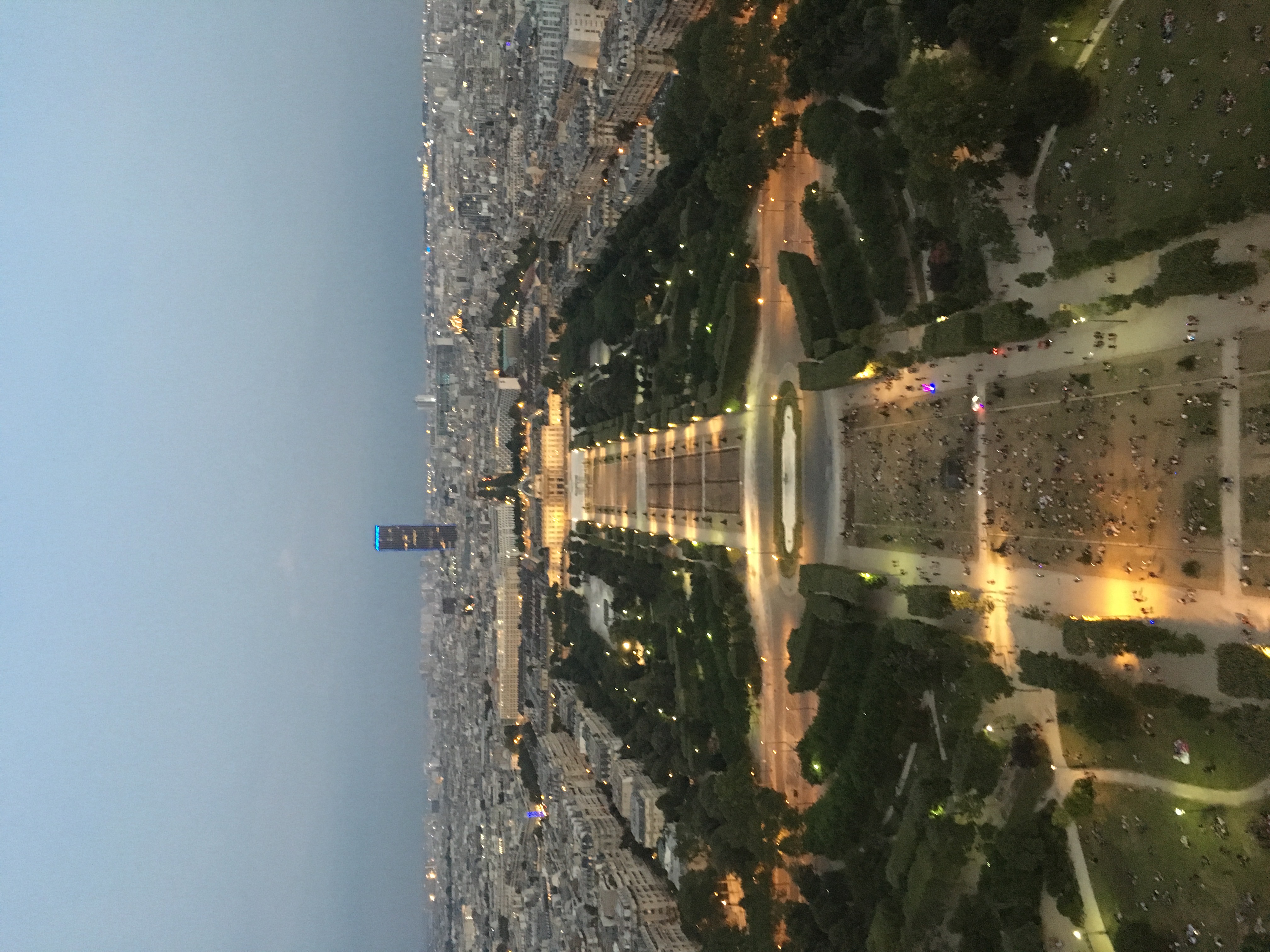
You’ve come a long way on your trip, don’t try to save €15 now!
The best time to go is at dusk.
This allows you to see the area while still light but remain up there while it becomes dark and then see Paris lit up at night.
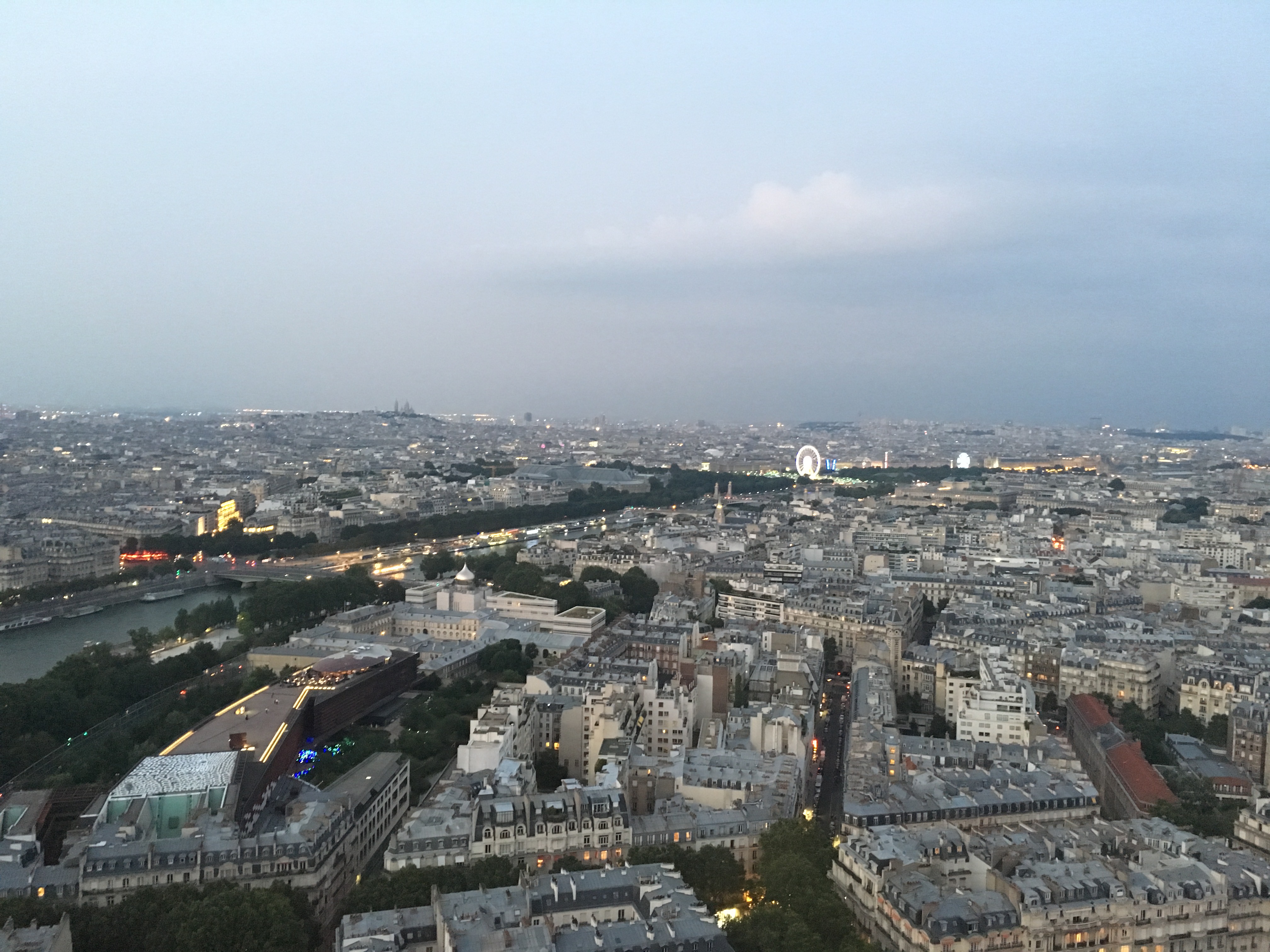
Booking ahead (especially in summer and at a time of your choosing) is essential. You can line up for tickets, but having them pre-booked online, can save you many hours of waiting during the high season (which includes the week between Christmas and New Year).
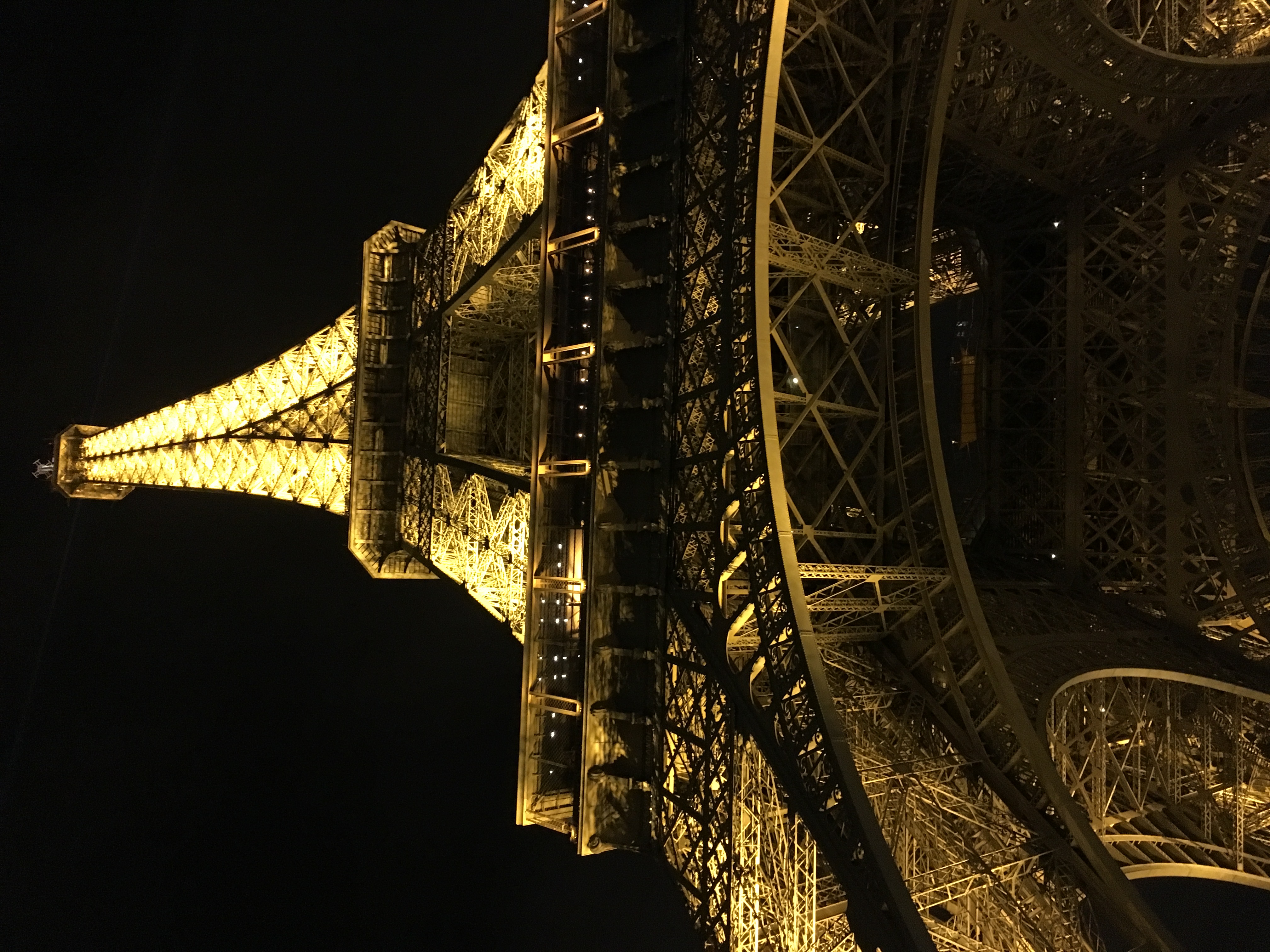
You can see the Tower from many locations in Paris.
You will randomly turn a corner or come out of a metro station and there it will be.
Despite having been to Paris a number of times, it still takes my breath away when I see it, especially when I wasn’t expecting too and it certainly says, “Welcome to Paris!”
The tower is open from 9am – midnight and tickets can be pre-purchased from the following link.
https://www.toureiffel.paris/en/rates-opening-times
2. Musee du Louvre
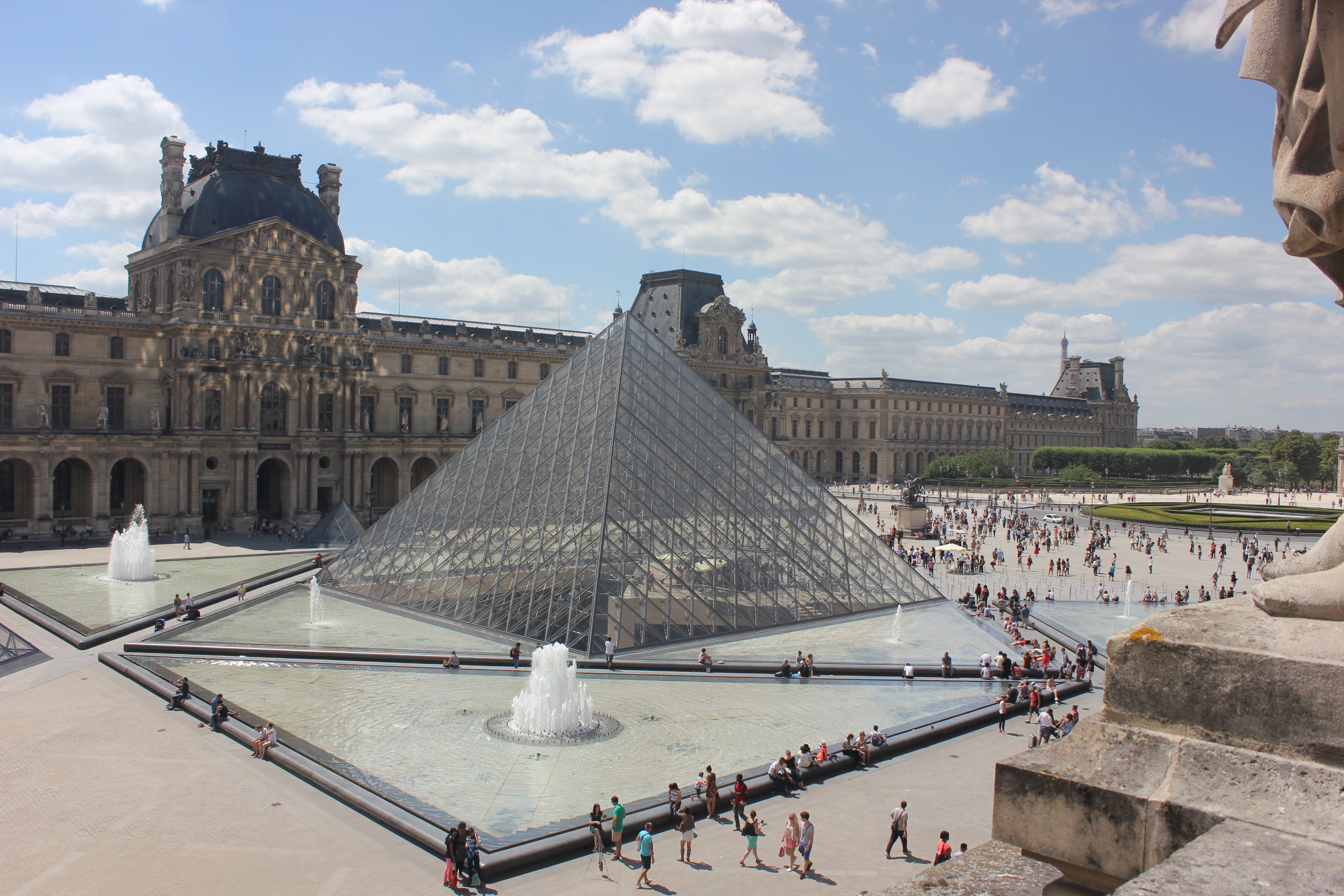
The Louvre is THE most visited art museum in the World. A trip to Paris would not be complete without going to see some of the amazing art works on display.
If you were to stop for 30 seconds at every exhibit, you would be in there for 6 months(!), so you will need to work out what you want to see, or just wonder around and admire the magnificent architecture.
After entry, you can pick up a ‘best of’ brochure, that points out the most famous items, if you are wanting to be strategic about the time you spend in there.
The history of the Louvre dates back to 1190 when it was a fortress constructed by King Phillip II of France to protect the city from invaders. King Charles V created a royal residence from it in the 14thC but after the French Revolution, when the property of Louis XVI became nationalised, the Louvre, as a museum, was born.
The galleries span over 15 acres, making it, not only the most visited, but also the largest in size, needed for over 480,000 pieces of art.
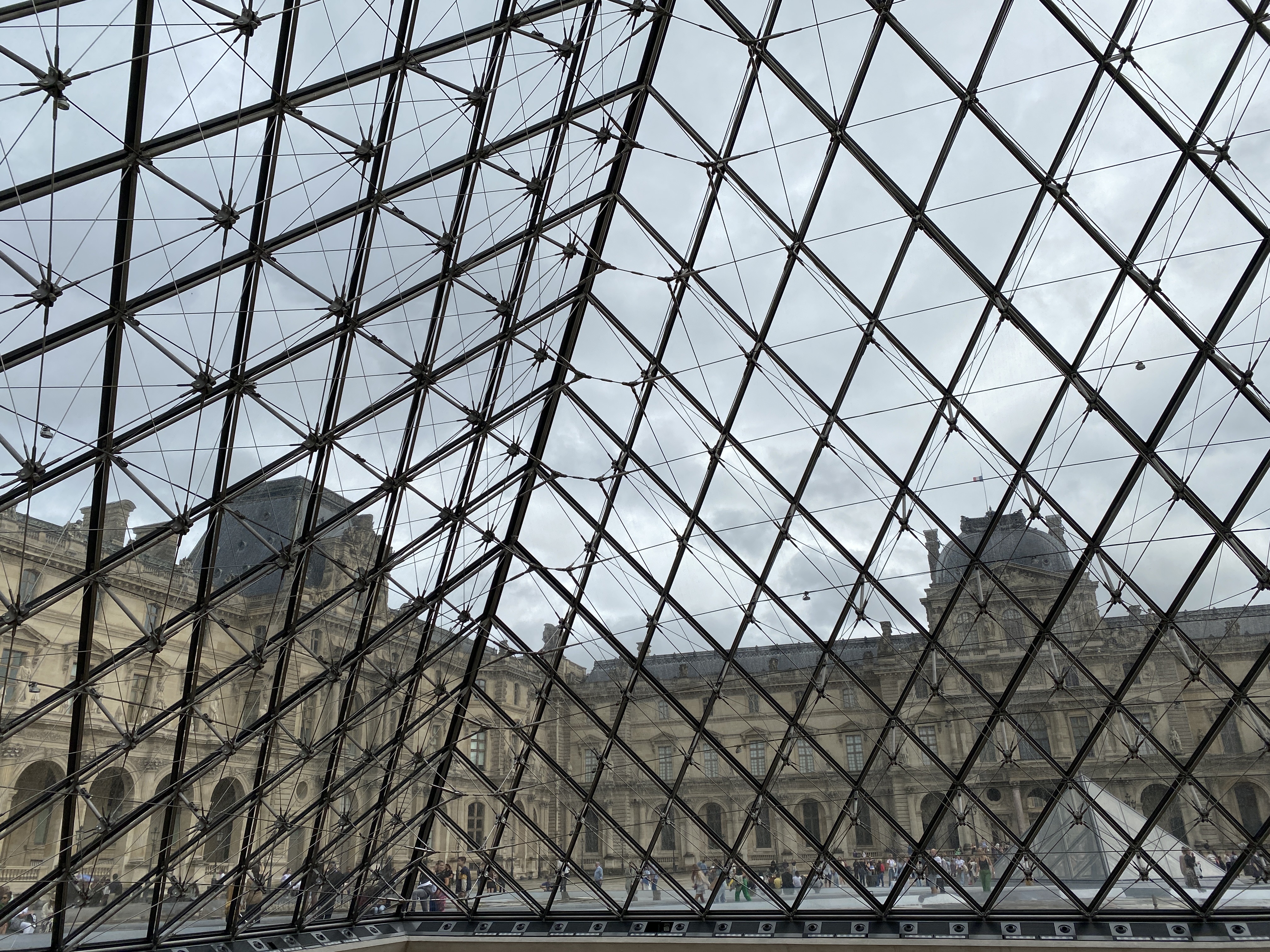
During WWII, the assistant director of the French National Museums, saw that the Nazis had plundered many museums on their way to France, and he wanted to protect as many of the Louvre’s art works as possible.
In the 2nd half of 1939, two hundred trucks carried priceless items from the Louvre’s collections to various locations to keep them safe. They were moved several times during the war but not one was destroyed, even with bombings, and in 1947 they were all returned to the Louvre safely.
There are many magnificent pieces to see and rooms to view, but I’ve listed here just a few to give a taste of what you can see.
The Mona Lisa
Arguably The Louvre’s most famous painting is that of Da Vinci’s, Mona Lisa.

Housed on Level 1, Room 711 the museum operates a line-up system, and you will need to be patient in order to walk quickly past. The above photo shows the people in the ‘snake’ queue to see it when we visited last month. This was different to a previous visit, where people just crowded around a semi-circle and pushed their way to the front!
It is a small painting, given its reputation, so you may find yourself disappointed with its size but see it you must, if only for the bragging rights later!
Protected behind bullet proof glass, the painting is one of the most famous, but least know about in history.
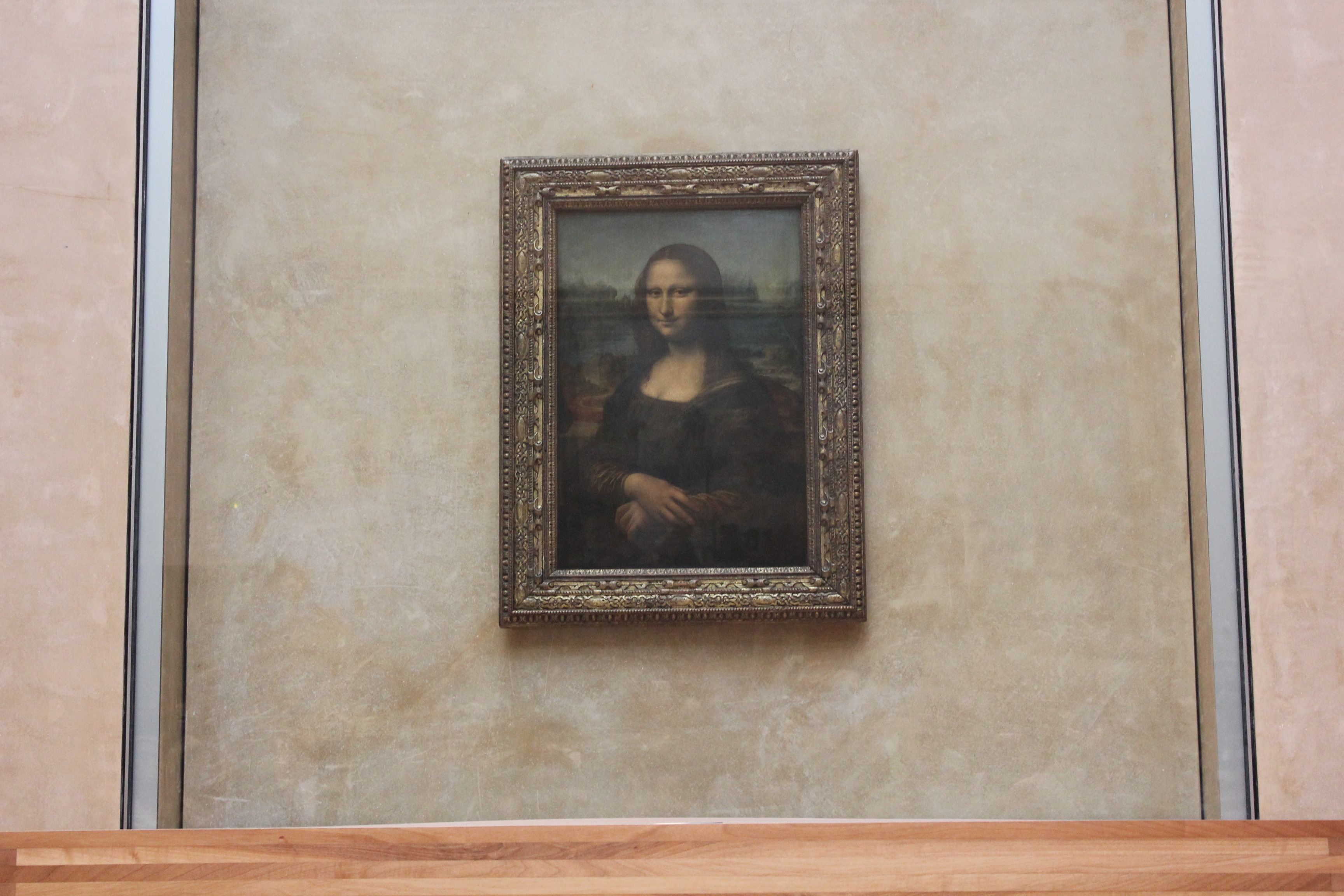
Historians are not certain about when it was painted, or who is the subject.
It is thought that it was painted between 1503-1506, when Leonardo was commissioned by Francesco del Giocondo to paint a portrait of his wife, but this has never been definitively confirmed. Even-so, the painting was never given to Francesco and Da Vinci left it to his apprentice Salai in his will.
Following a discovery in 2005 by a scholar at Heidelberg University in Germany, it was confirmed that Da Vinci was painting Lisa del Giocrondo in 1503, but despite this, the Italian painting curator of the Louvre, was still cautious about whether the Mona Lisa portrait is actually her because we cannot be certain that this was what he was painting at that time.
Besides a couple of exhibitions elsewhere, it has been on permanent display in the Louvre since 1797 and was not considered a masterpiece until 1911, when it was famously stolen from the Louvre and not recovered for over two years.
Venus de Milo
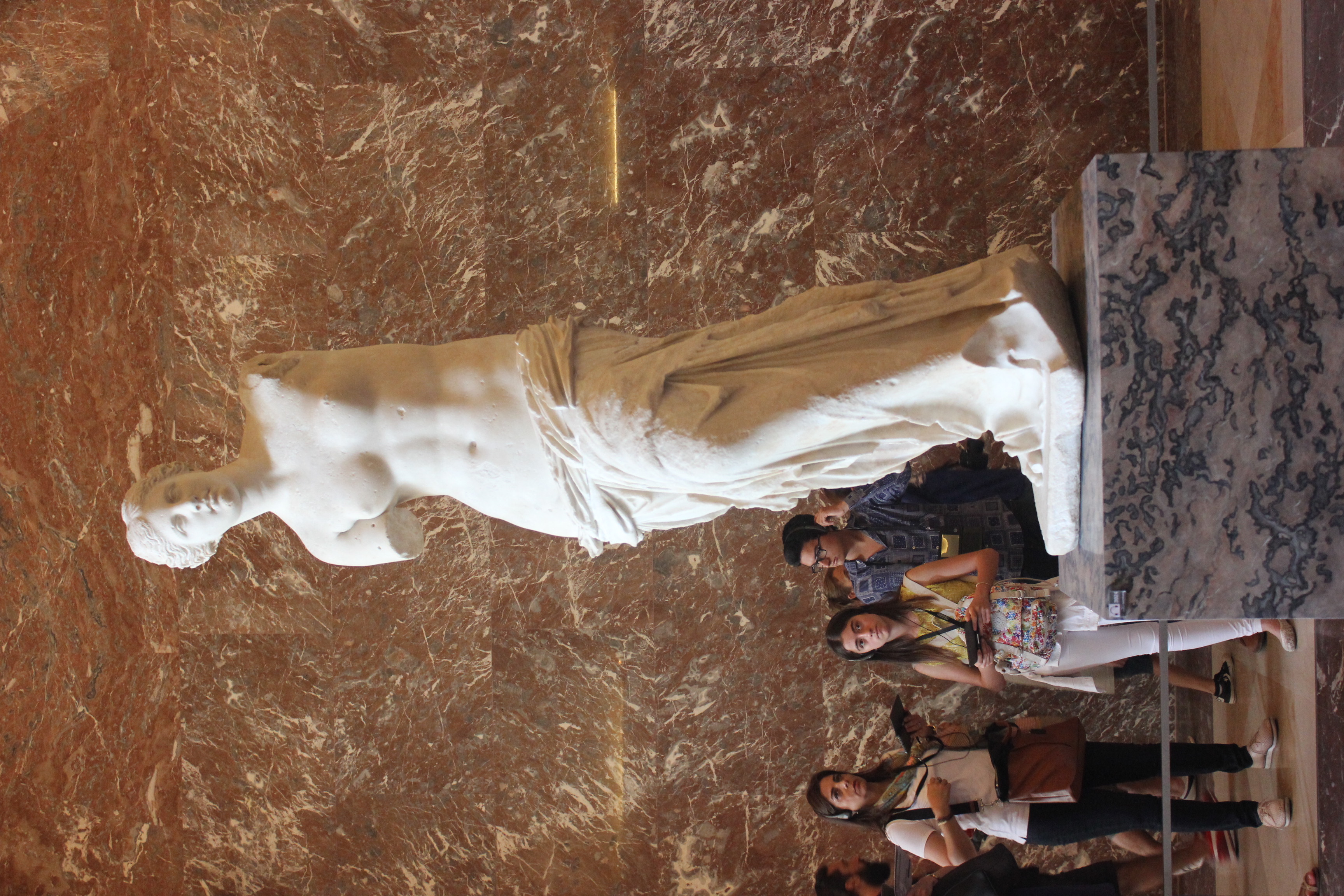
Discovered on the Greek island of Milos in 1820 by a farmer, the statue measures over 2 metres tall and is made of Parian marble. It has both arms, a foot and earlobes missing. Some of these were found near the statue when it was discovered but subsequently went missing.
It is believed to be the Greek goddess Aphrodite, and an inscription found near the statue saying, ‘Alexandros of Antioch’, who was a sculptor of the Hellenistic age, suggesting he may have created the masterpiece.
While the dating of it is disputed, it is thought to have been from the late Hellenistic period, so approximately 150BC – 50BC.
Liberty Leading the People
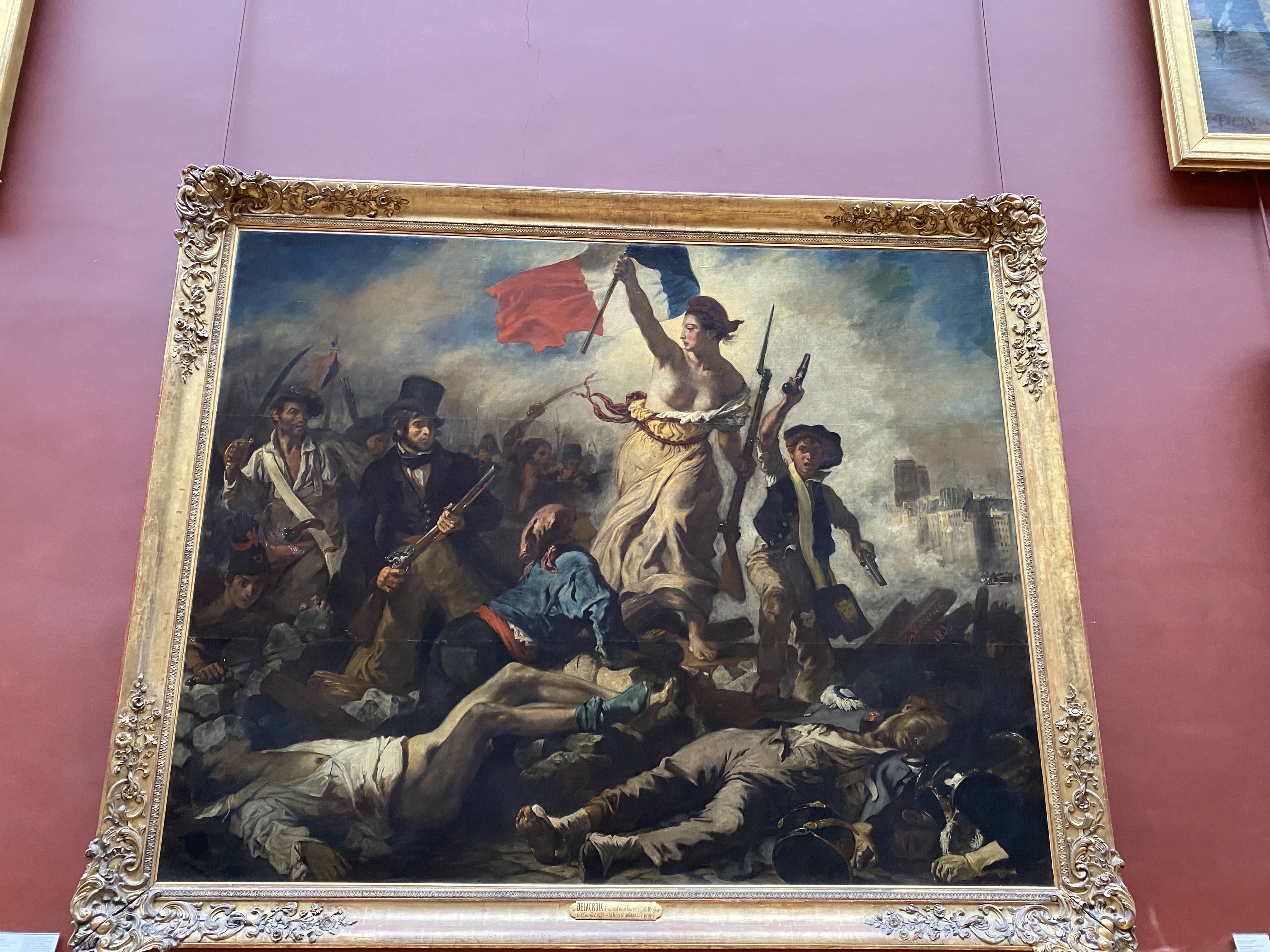
Painted by Eugene Delacroix, the painting depicts the ‘three glorious days’ of the French Revolution of July 1830.
Viewed as the symbol of France and the French Revolution, lady Liberty is holding the French national flag in one hand and a bayonet in the other.
The people are depicted breaking through a barricade during the uprising against King Charles X.
Coronation of Napoleon
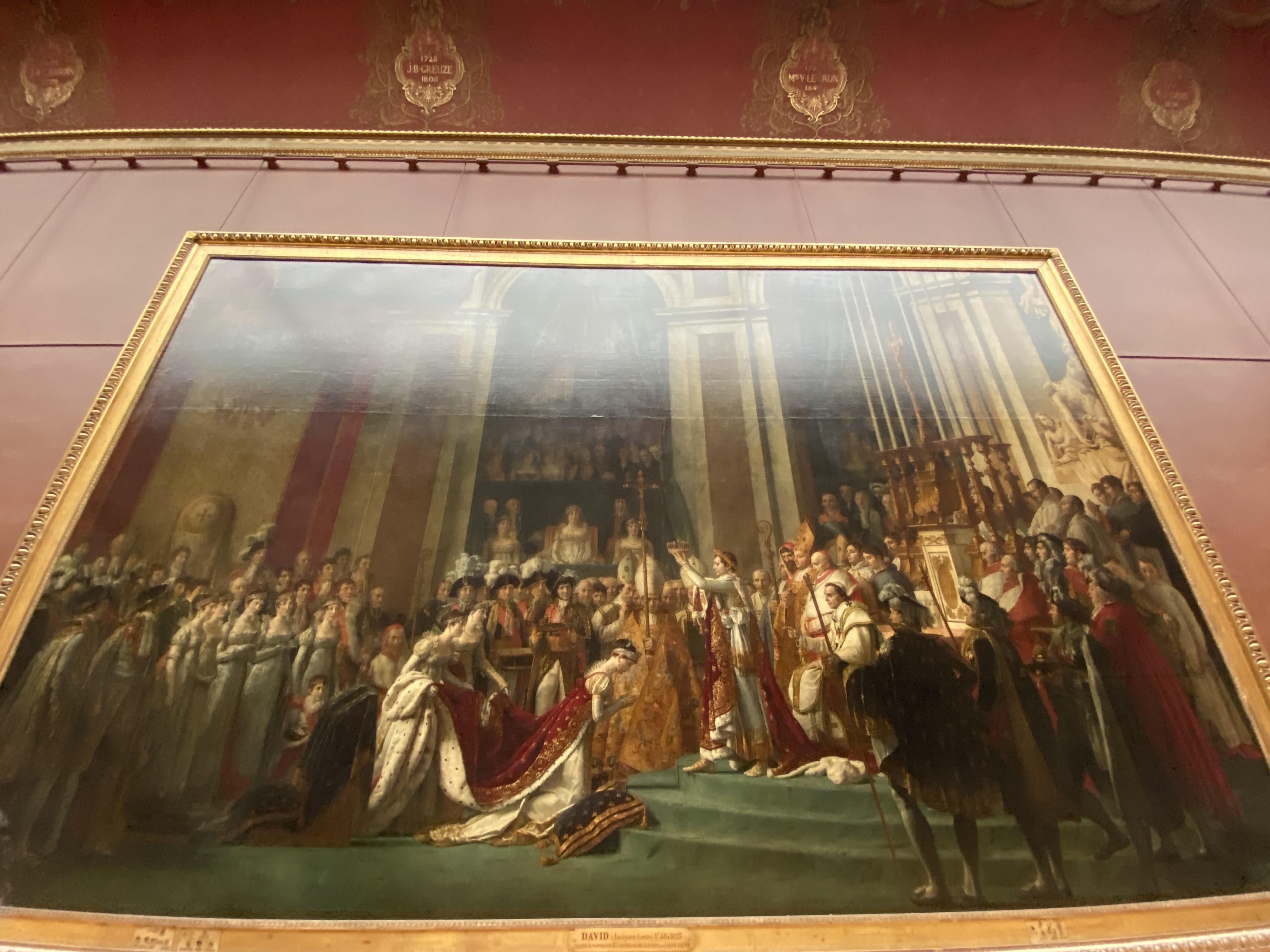
The painting of Napoleon’s coronation by Jacques-Louise David is a massive piece measuring 30 feet by 22.
In it we see, Napoleon holding Josephine’s crown up as he is about to place it on her head with Pope Pius VII seated behind him. The image has 191 individuals watching the consecration which occurred on December 2nd, 1804.
Earlier, Napoleon had taken his own crown (that of a laurel wreath, like Julius Caesar) from the Pope’s hands and placed it on his own head, as a display of ‘might’ in being the new Emperor.
A copy, also painted by the artist, hangs in the Coronation Room at Versailles.
The Winged Victory of Samothrace
https://www.louvre.fr/en/explore/the-palace/a-stairway-to-victory
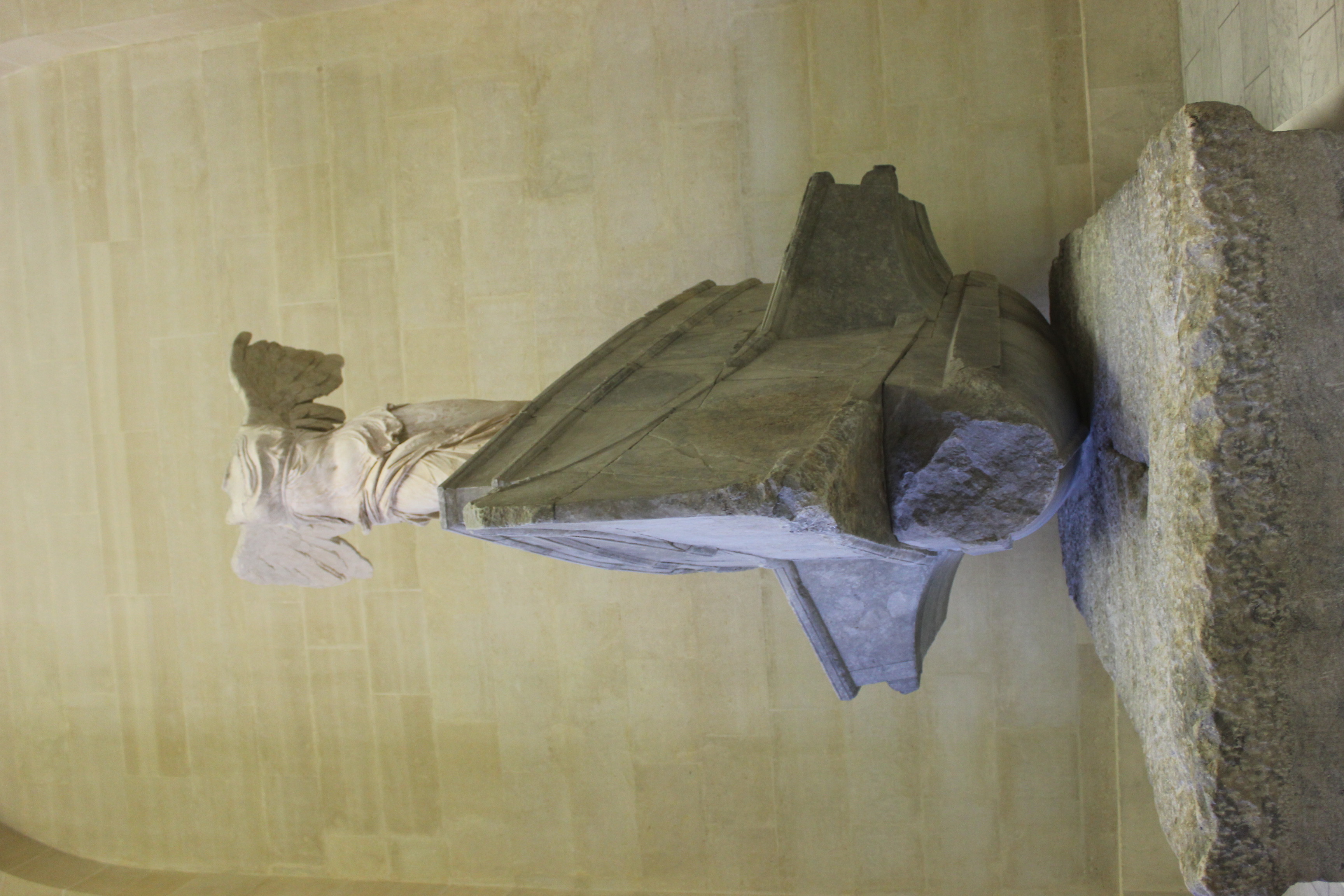
Hailed as the greatest depiction of the Greek idea of portraying Victory as a winged woman, the messenger of Zeus, the statue was discovered in 1863, by a French Vice-Counsul to Turkey on the island of Samothrace, which is in the north-eastern Aegean Sea.
It consists of three pieces, a pedestal, a grey marble base and the white Parian marble statue.
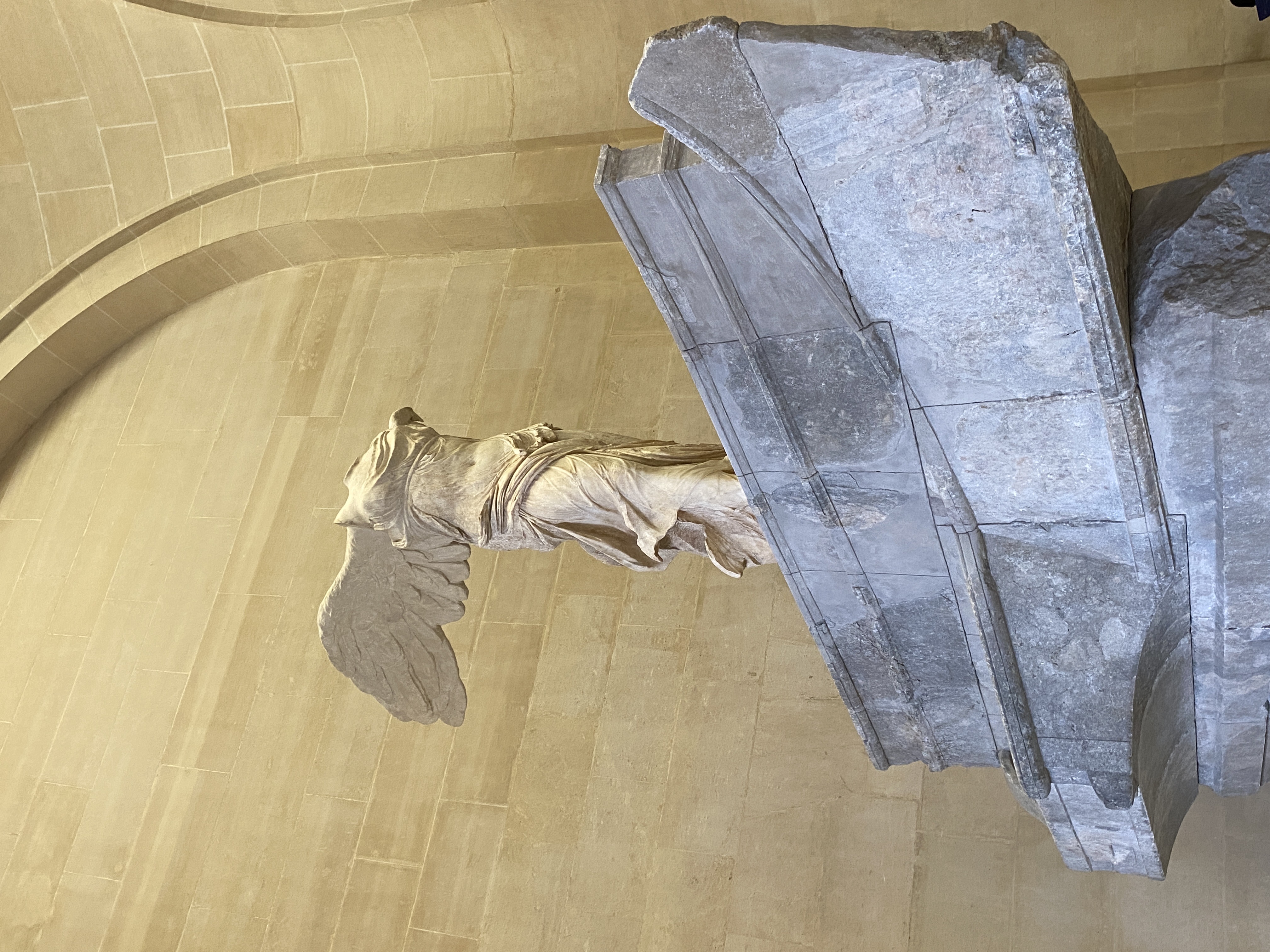
It’s place in the Louvre, at the top of the Daru staircase, is also impressive and she has been situated there since 1883.
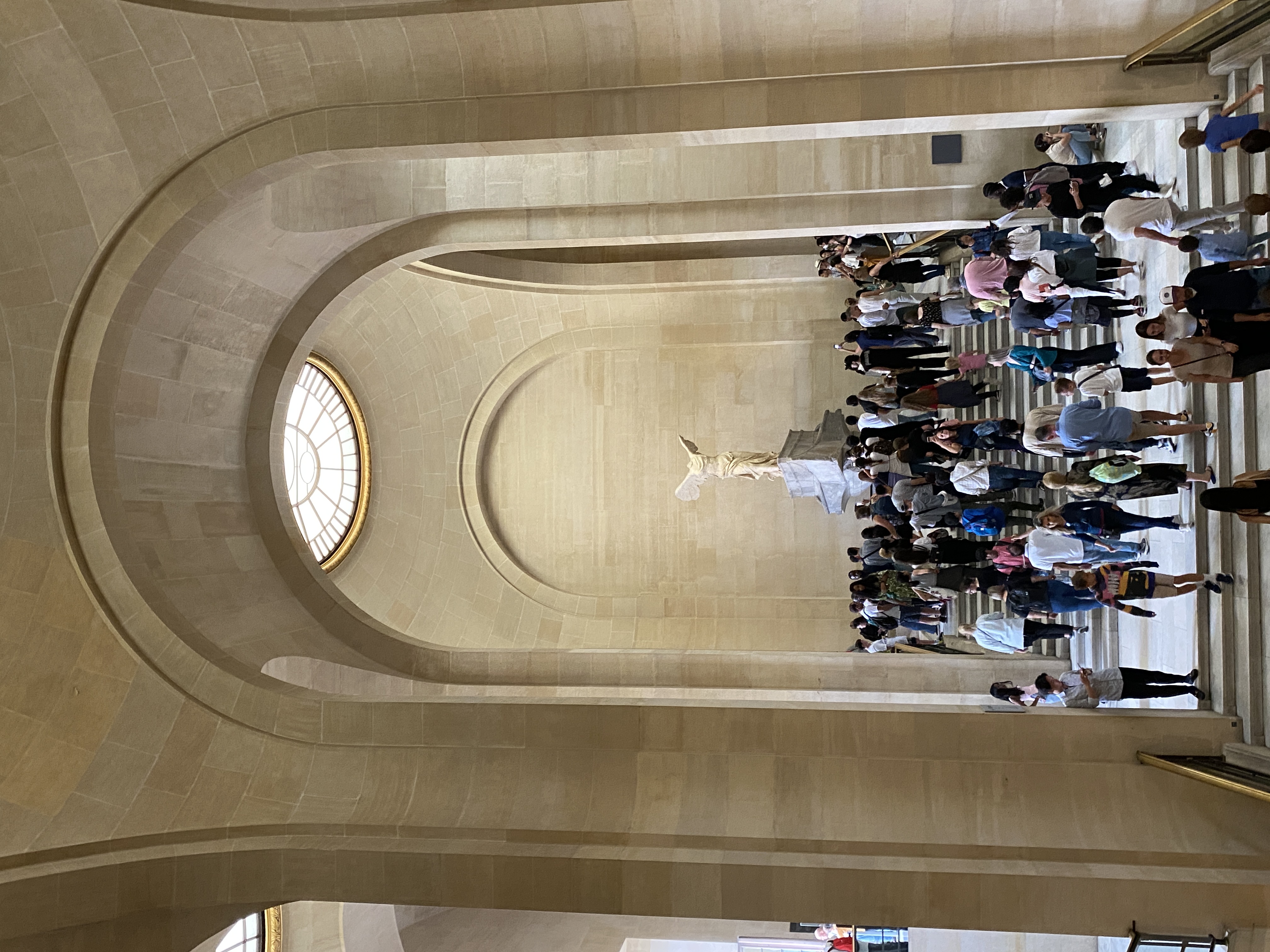
Royal Apartments
A section of the Louvre has been kept showing the royal apartments of Napoleon III.
Here is a small selection of the rooms you can see.
The Grand Salon

State Dining Room
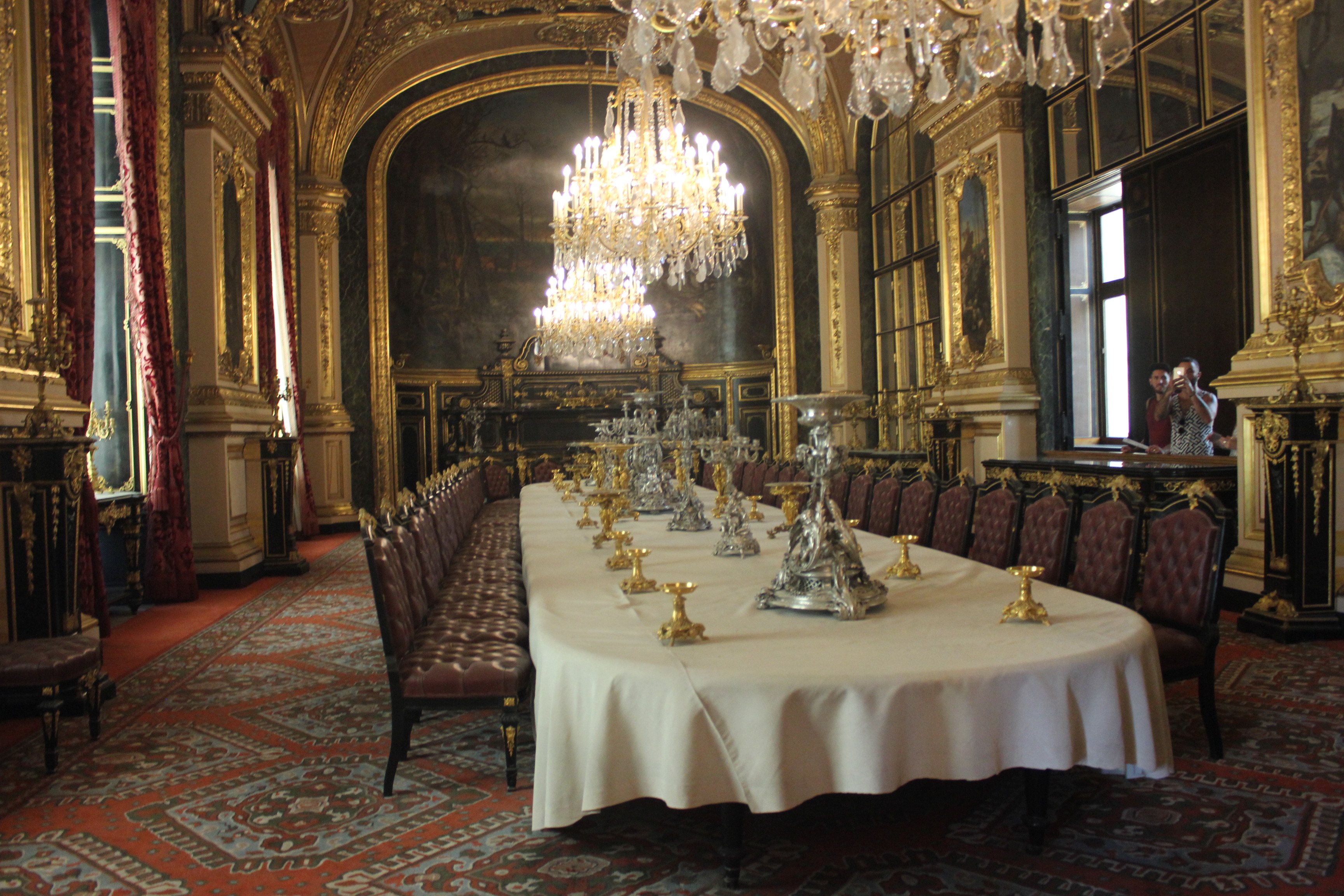
Bedroom
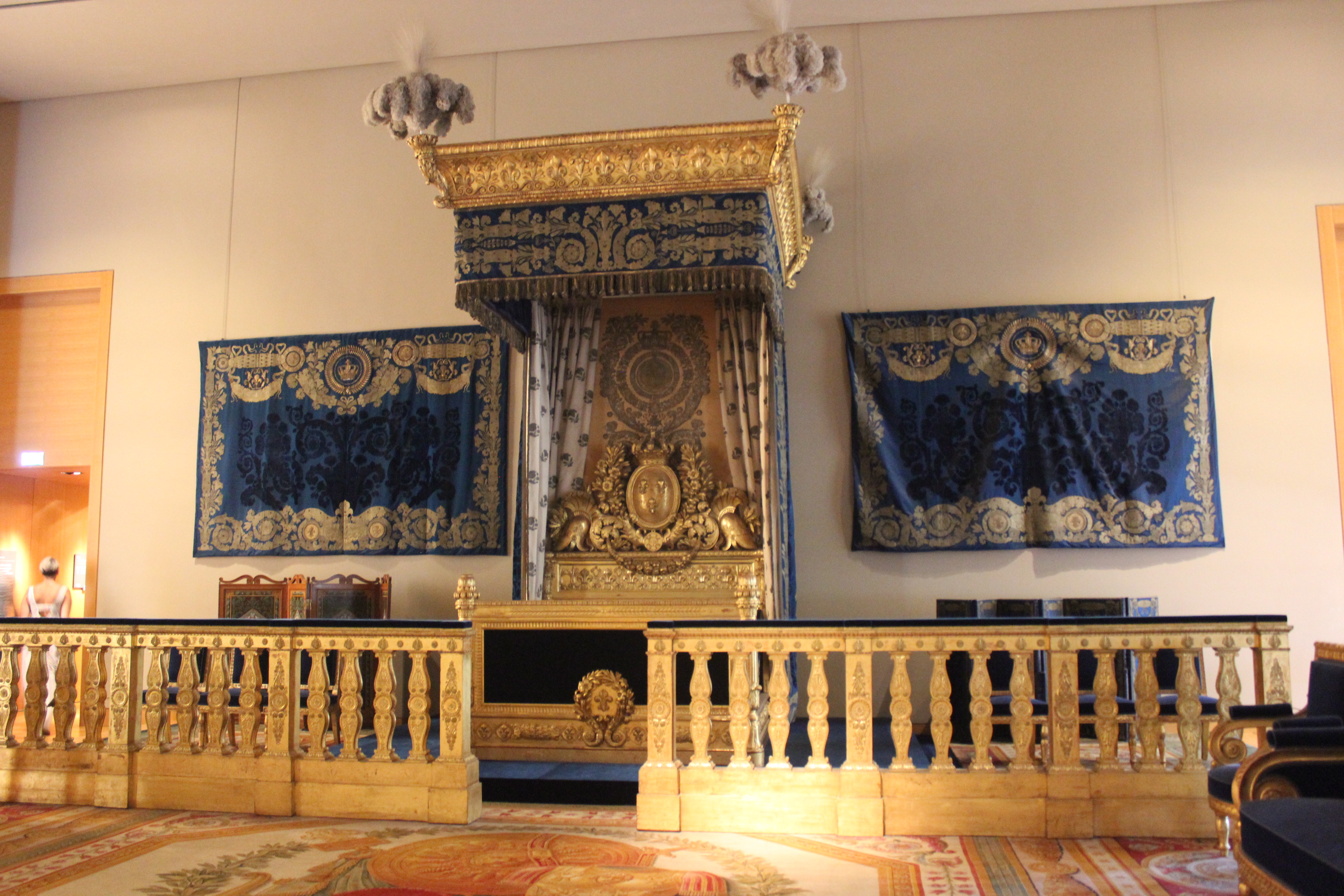
The Wedding Feast at Cana
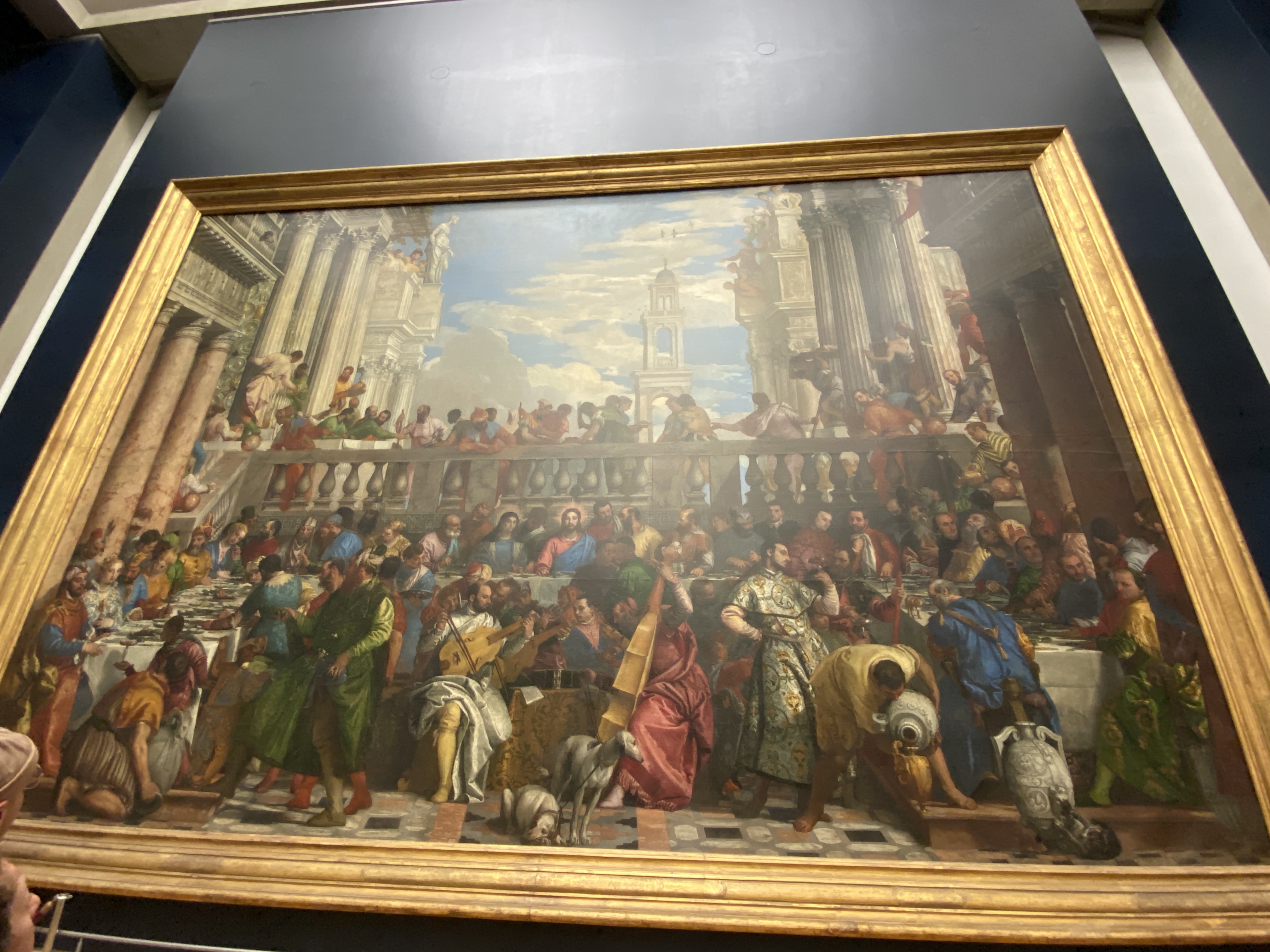
The largest painting in the Louvre, The Wedding Feast at Cana, is an incredible six meters high and 10 meters wide!
Interestingly, it is displayed on the opposite wall to the Mona Lisa! When we were there recently, many people had eyes only for the small painting and miss seeing it, in their rush to the line-up for Da Vinci’s masterpiece.
The wedding feast, attended by Jesus (seated in the middle), his mother and the disciples has 130 different characters. The marriage in Cana of Galilee, is the story depicted in the Bible Gospel according to John, where Jesus turns water into wine. It was painted by Paolo Veronese in 1563 and is of the late Renaissance period.
Louvre Architecture – Inside & Out
A visit to the museum can also just be a walk around some of the most intricate and beautiful rooms in the world. There are so many highlights, especially with the addition of the pyramids, opened in 1989.
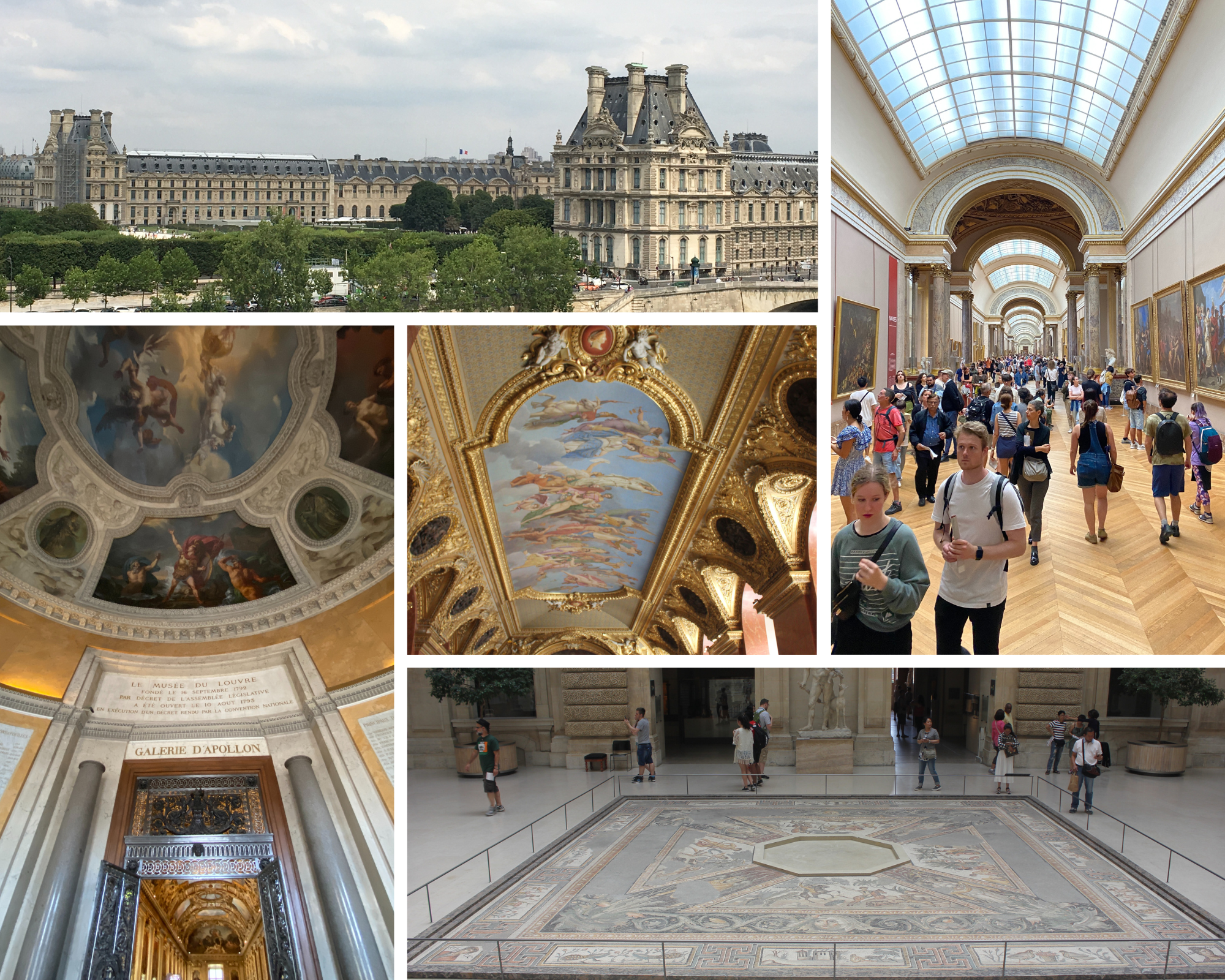
As I mentioned at the beginning, there are so many works of art and rooms to see in the Louvre, you would need six months to see them all, so when you go, you will need to plan what you see.
The museum provides a good map to help you know what there is to view and also points out some highlights. I’ve induced the link below for you to take a look before you go.
Louvre Map
https://api-www.louvre.fr/sites/default/files/2023-07/BAT-EN%20LOUVRE_PlanG%20-%20MAI%202023.pdf
Louvre Tickets
https://www.ticketlouvre.fr/louvre/b2c/index.cfm/home
The Louvre Online
If you would like to explore the Louvre’s collection online, these links allow you to do that, and provide a very good virtual walk through.
https://www.louvre.fr/en/online-tours
https://www.louvre.fr/en/explore
3. Musee du Orsay
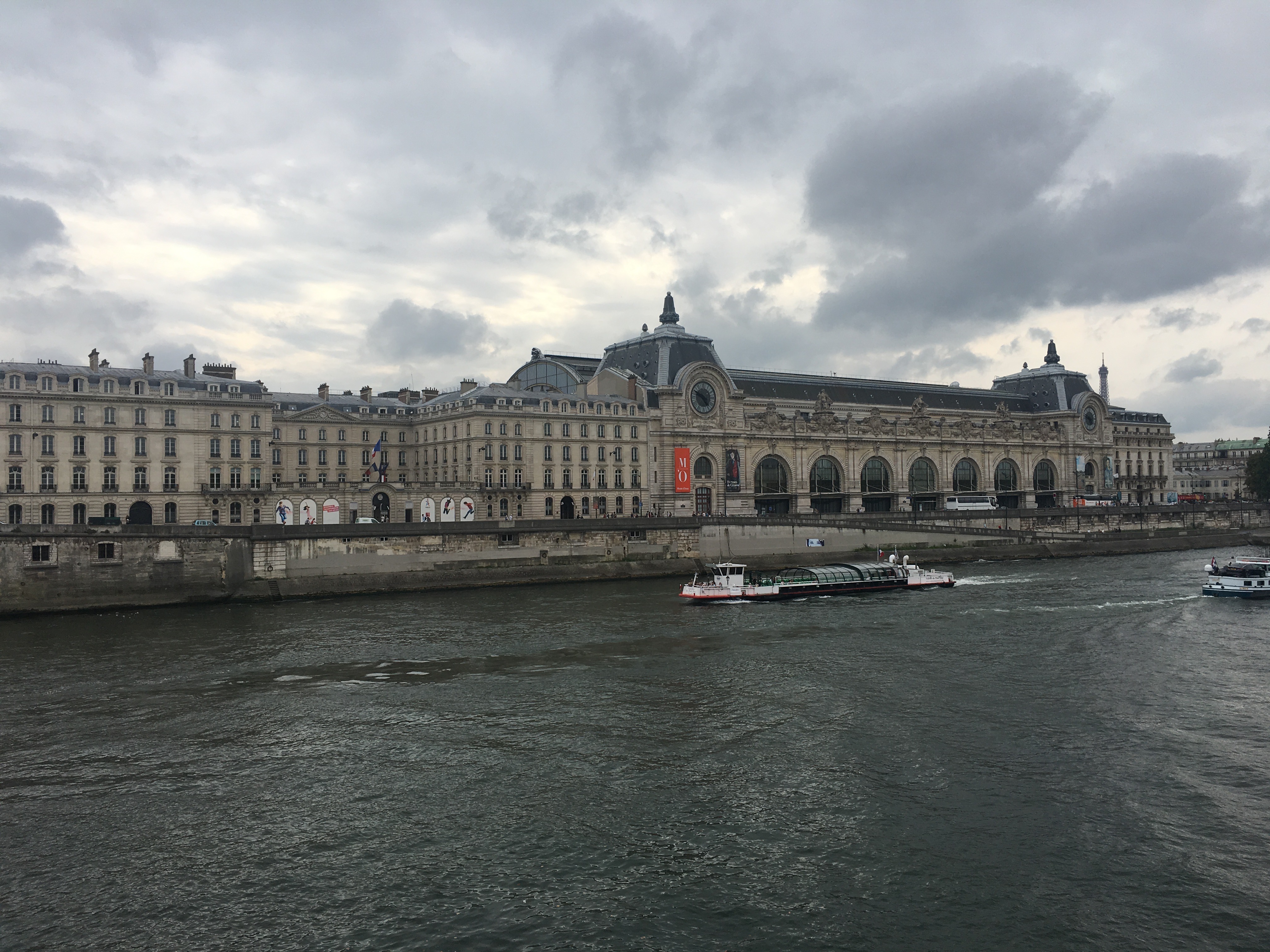
While the Louvre is, of course impressive, our favourite museum in Paris is the Orsay.
Built as a railway station, the Gare d’Orsay operated between 1900 – 1939, when it became unsuitable as trains became longer and its platforms were too short. It was originally planned to be demolished to make way for a hotel, but the French Cultural Minister at the time saved it and it was added to the Historical Monuments register in 1978.
The idea to turn the former railway station into a museum came from the Directorate of the Museum of France, as it was felt there was a gap between the Louvre and the more modern art museum, Georges Pompidou Centre.
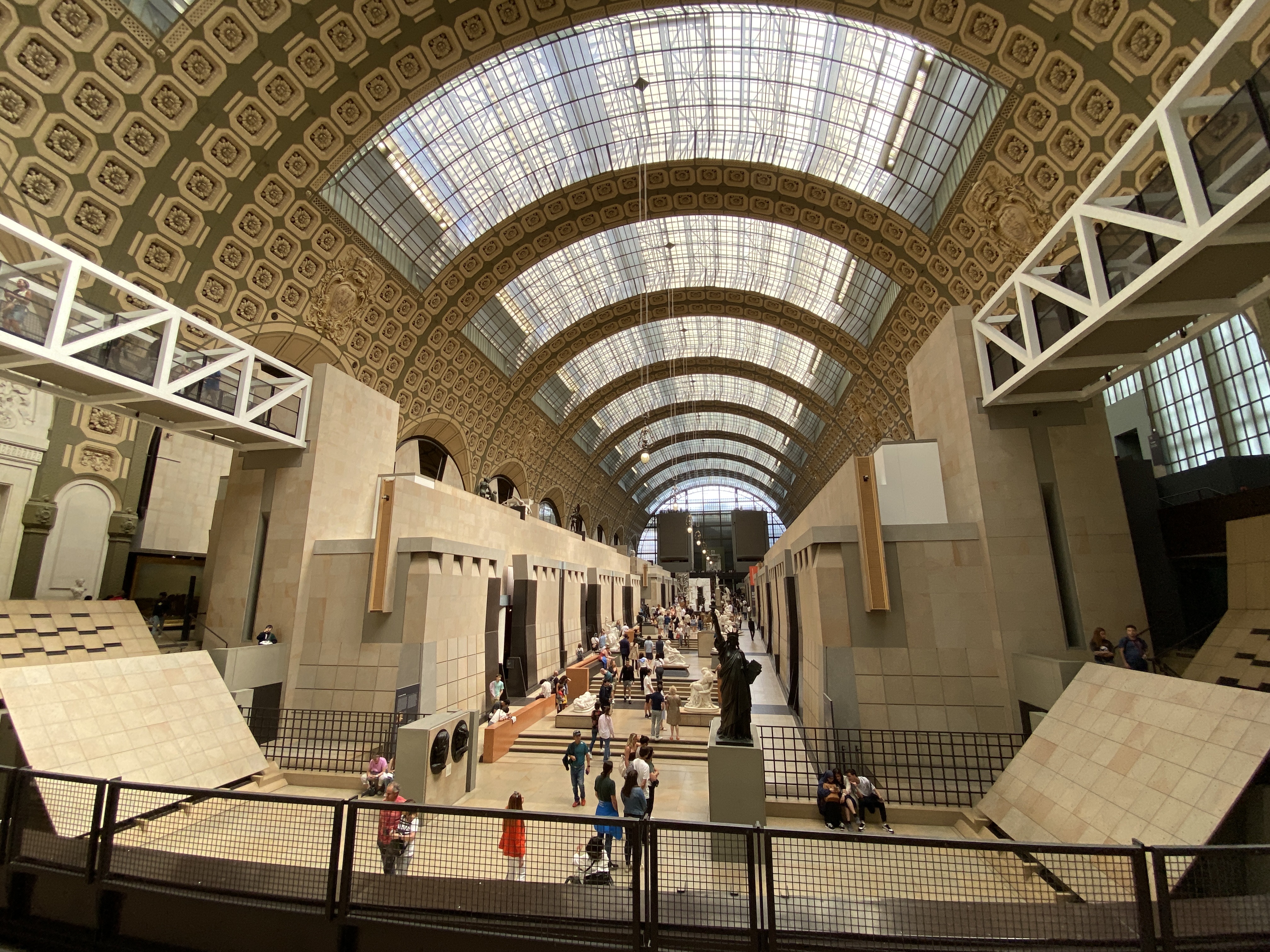
The museum houses mainly French art from 1848-1914 and has the largest collection of Impressionist and post-Impressionist masterpieces in the world.
It is the 6th most visited museum in the world and only 2nd to the Louvre in France.
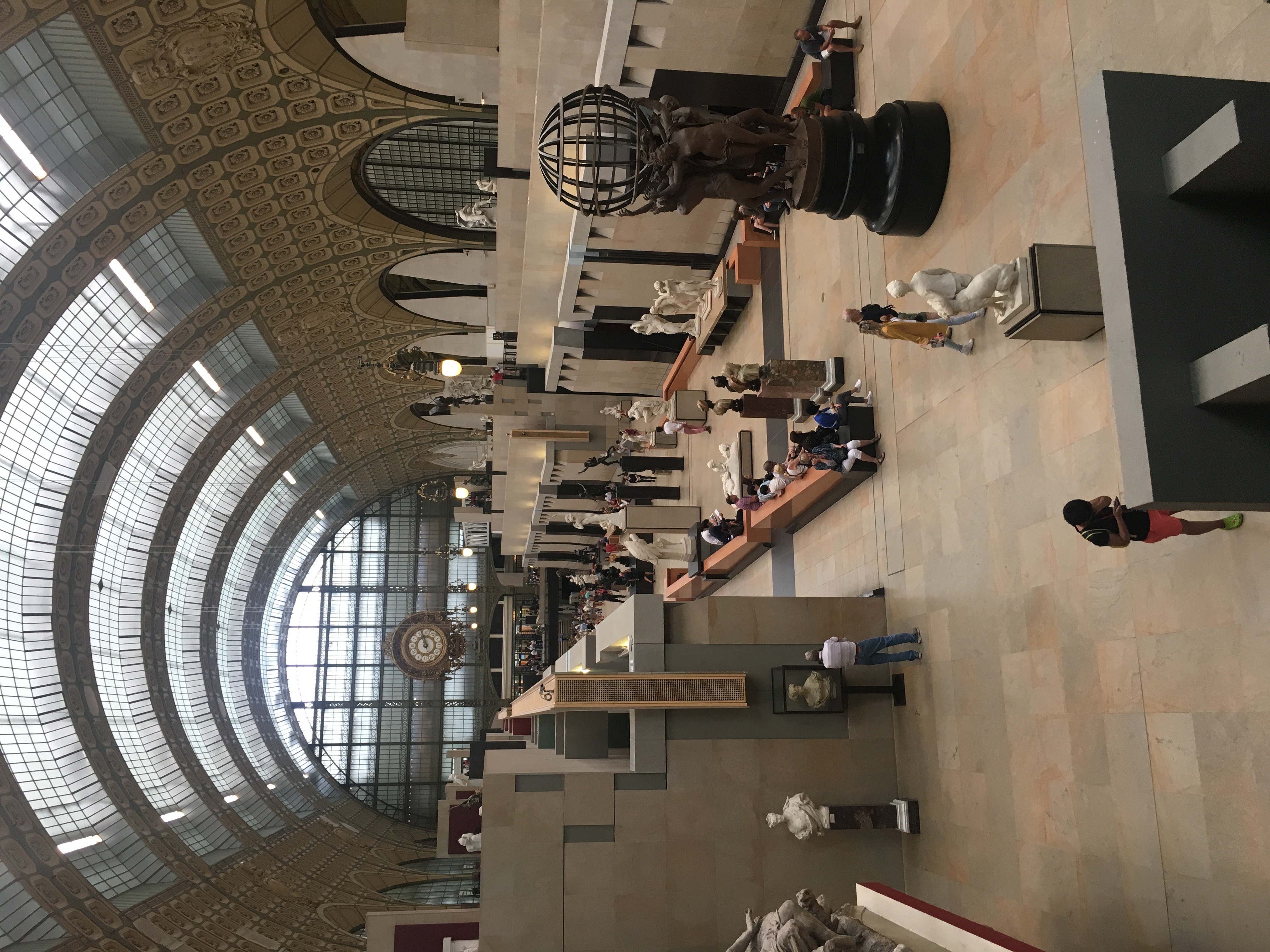
Many original features from the railway station were kept, such as the clock in the main hall.
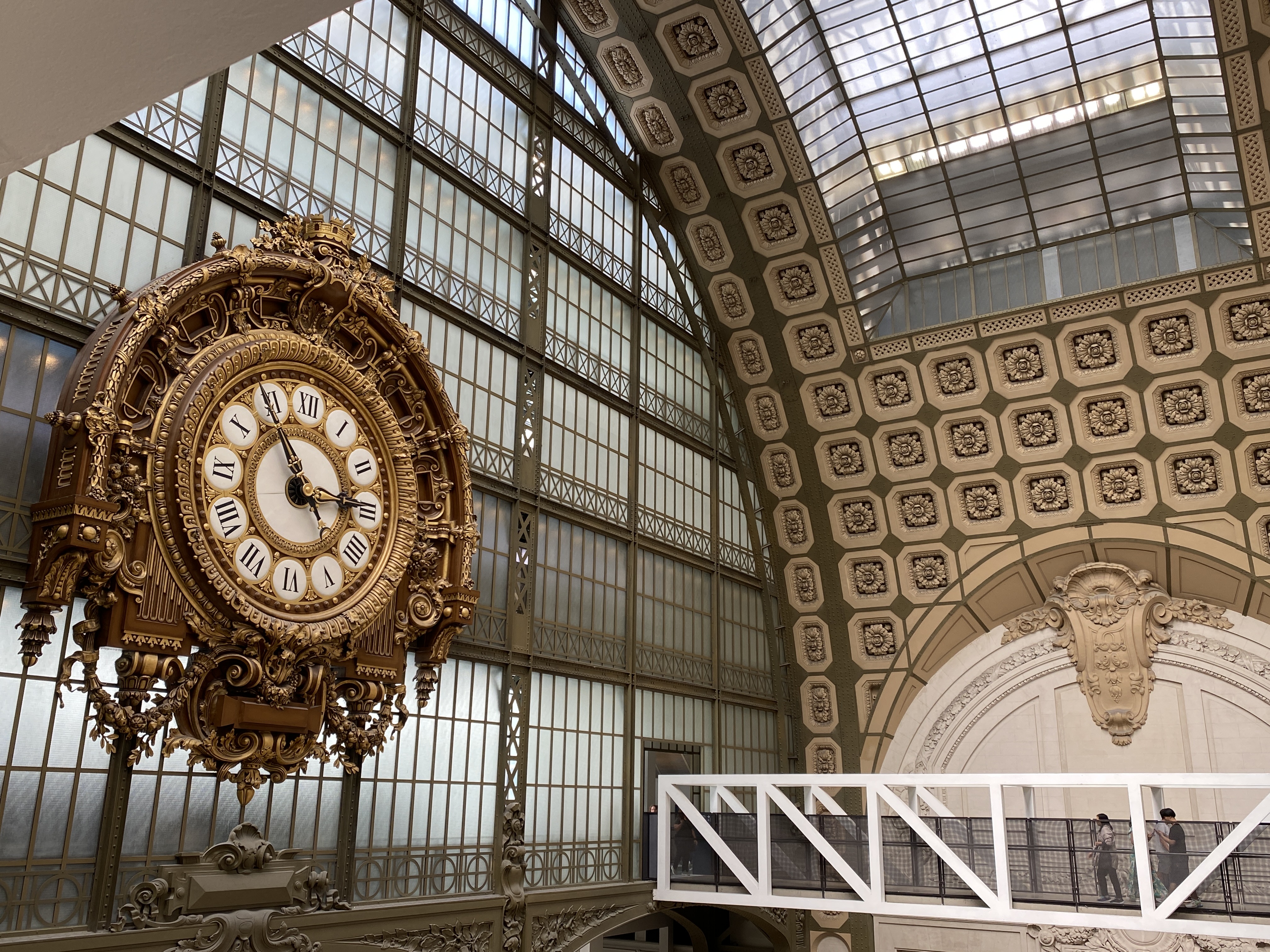
And the two external clocks, which have become pictorial focal points as visitors cross between galleries on the 5th floor.
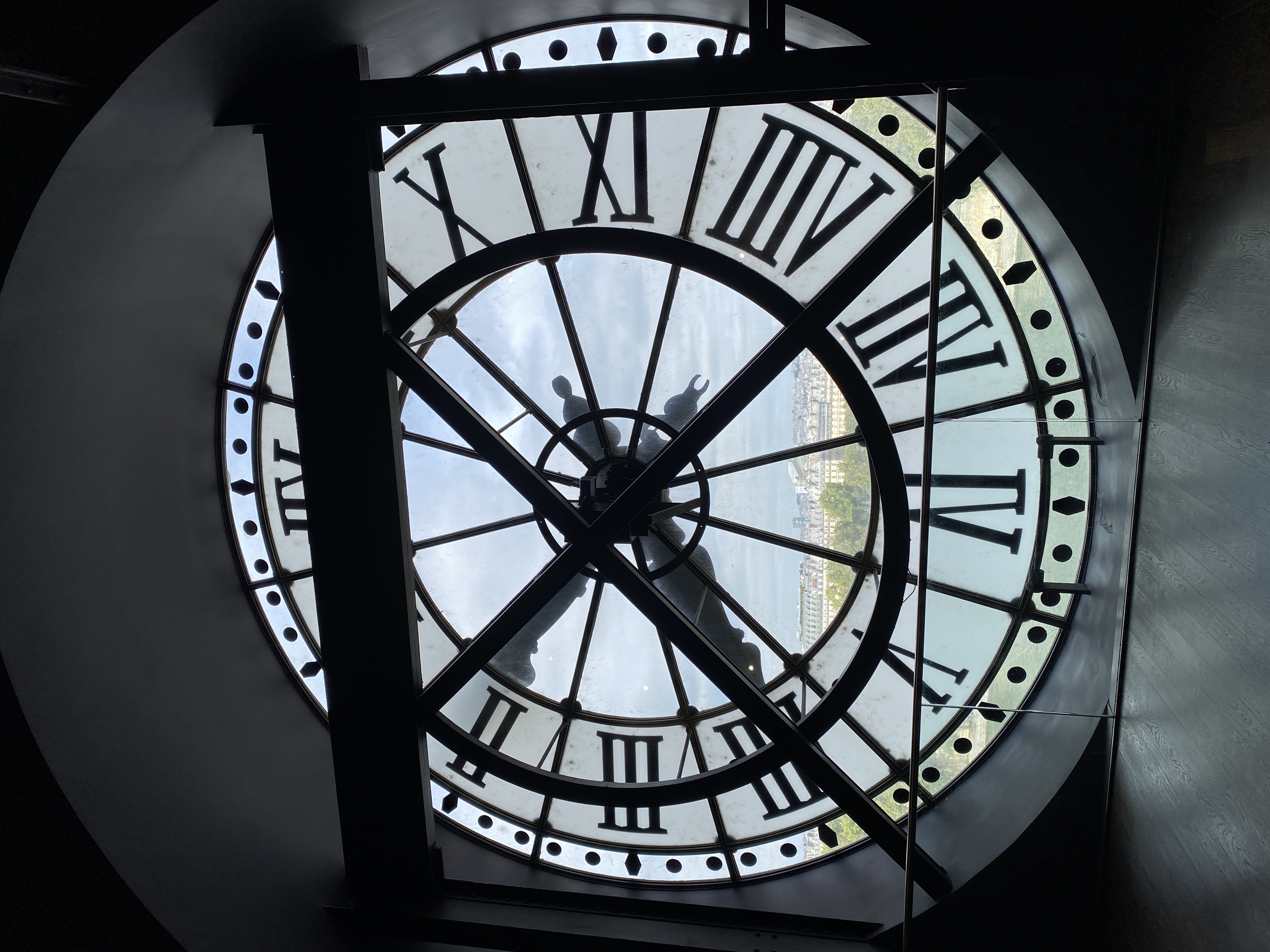
While the building itself is impressive, it is the art that everyone comes to see.
If famous impressionists/post-impressionists are your ‘thing’ then this is the place to see them.
Vincent Van Gogh – (1853 – 1890)
During his lifetime, Van Gogh would have considered himself an impressionist, but it has since been determined that because he was one of the pioneers and founders of expressionism, that he should be classed as a post-impressionist.
Regardless, if you are a Van Gogh fan, then you can’t beat the collection held by the Orsay. Only the Van Gogh Museum in Amsterdam has more works available in one location.
Starry Night over the Rhone
Van Gogh’s ‘Starry Night over the Rhone’ was painted in 1888. It is truly spectacular in real life, with its blues and gold, almost dancing off the canvas.
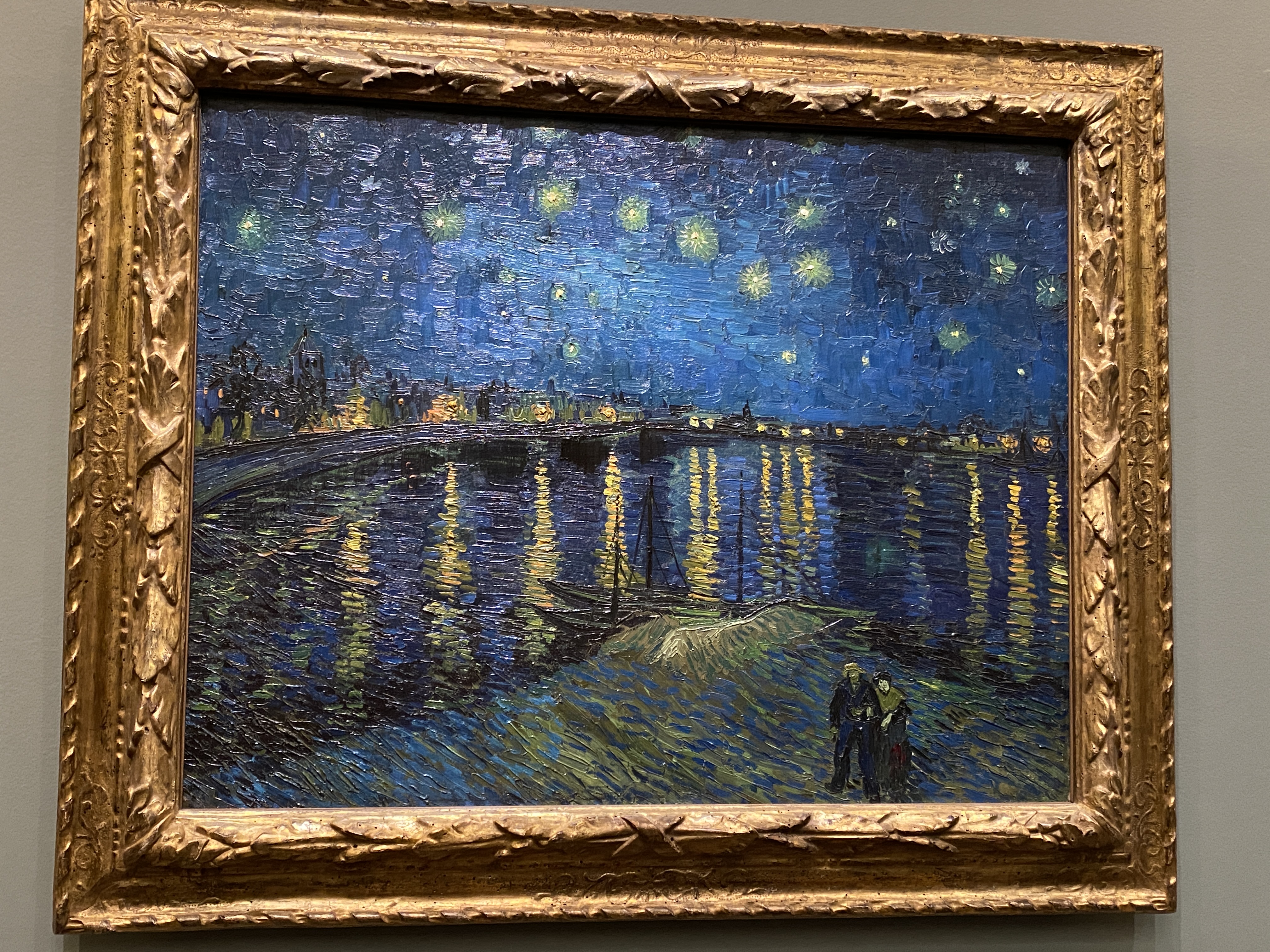
Self Portrait
Van Gogh painted a number of self-portraits during his time as an artist and this one was done in Saint-Rémy in September 1889, just before he left for Auvers. He sent the painting to his brother Theo and included a letter that read:
"You will need to study [the picture] for a time. I hope you will notice that my facial expressions have become much calmer, although my eyes have the same insecure look as before, or so it appears to me."
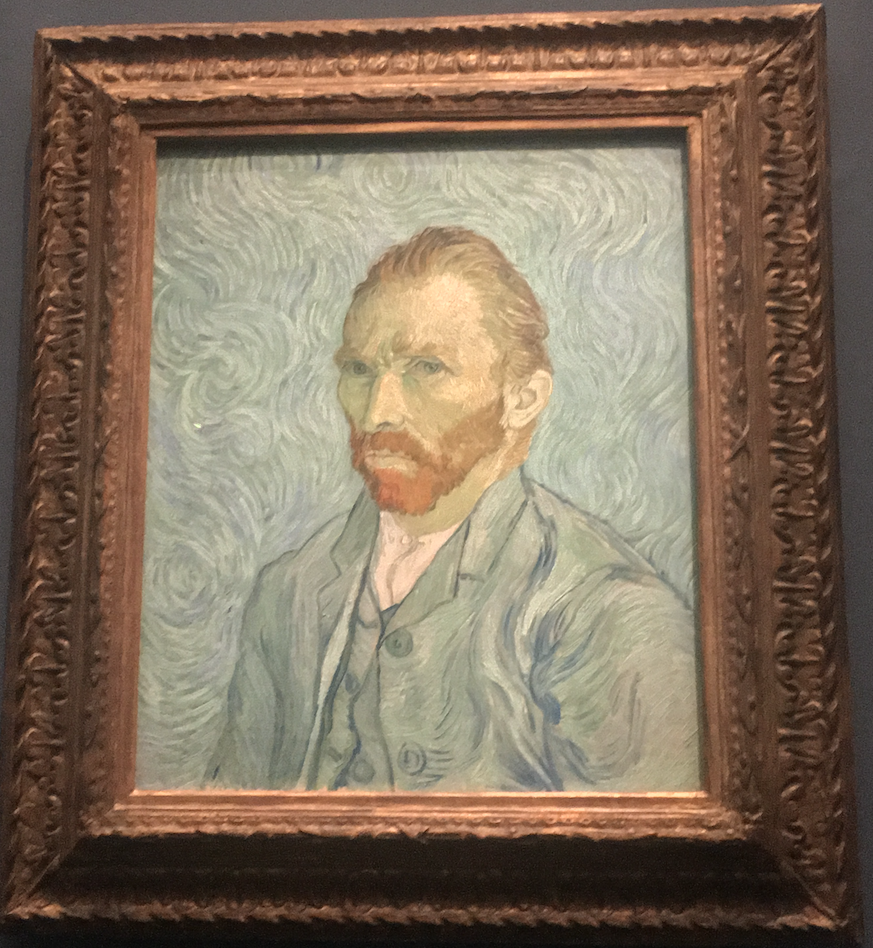
The Church at Auvers
Painted in June 1890, the church is in Place de I’Englise in Auvers, about 27 kms north-west of Paris.
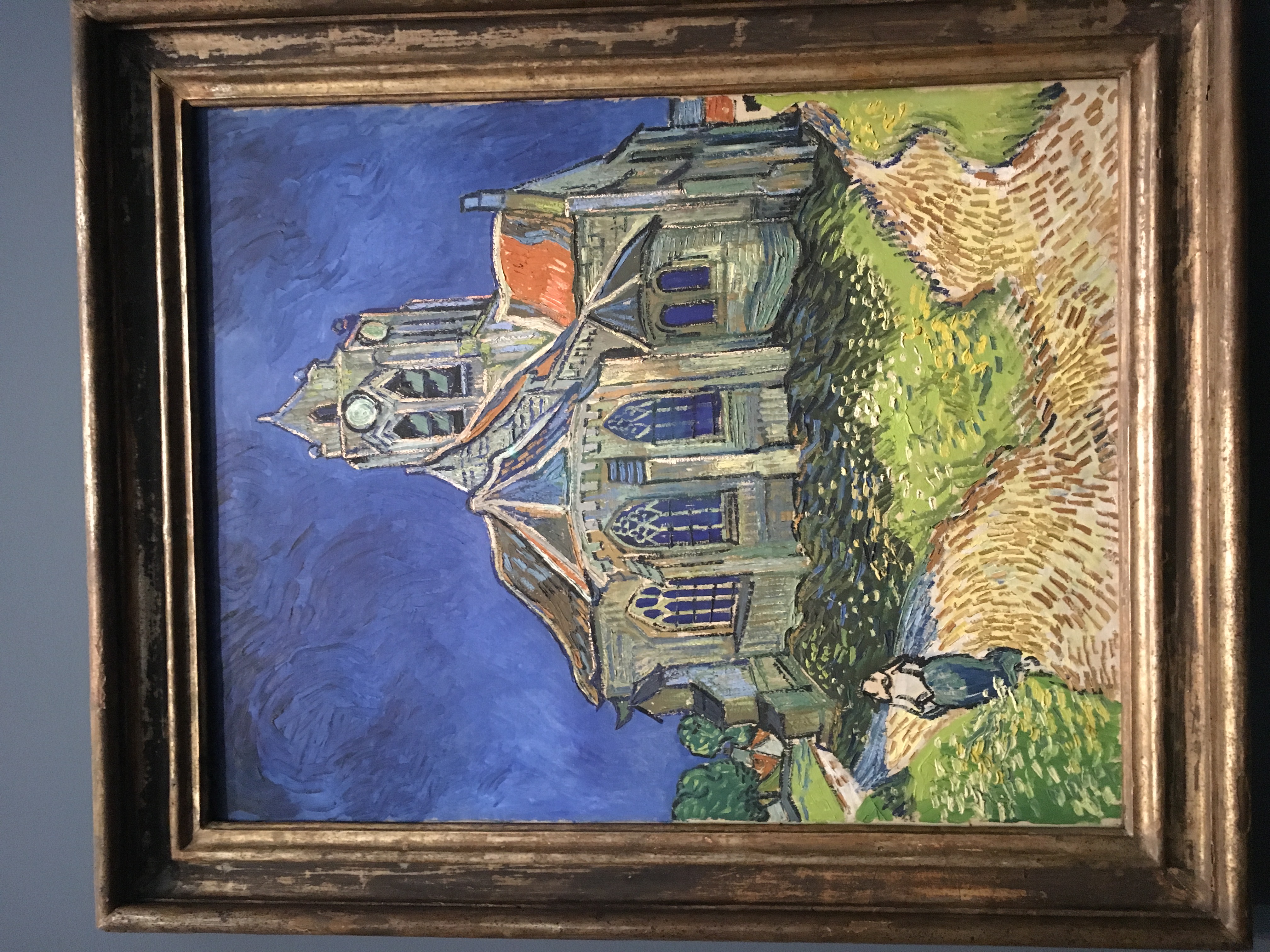
Bedroom in Arles
One of three versions that exist of his bedroom in Arles, this version was painted in the summer of 1889, during a time Van Gogh described as redoing some of his ‘best’ compositions.
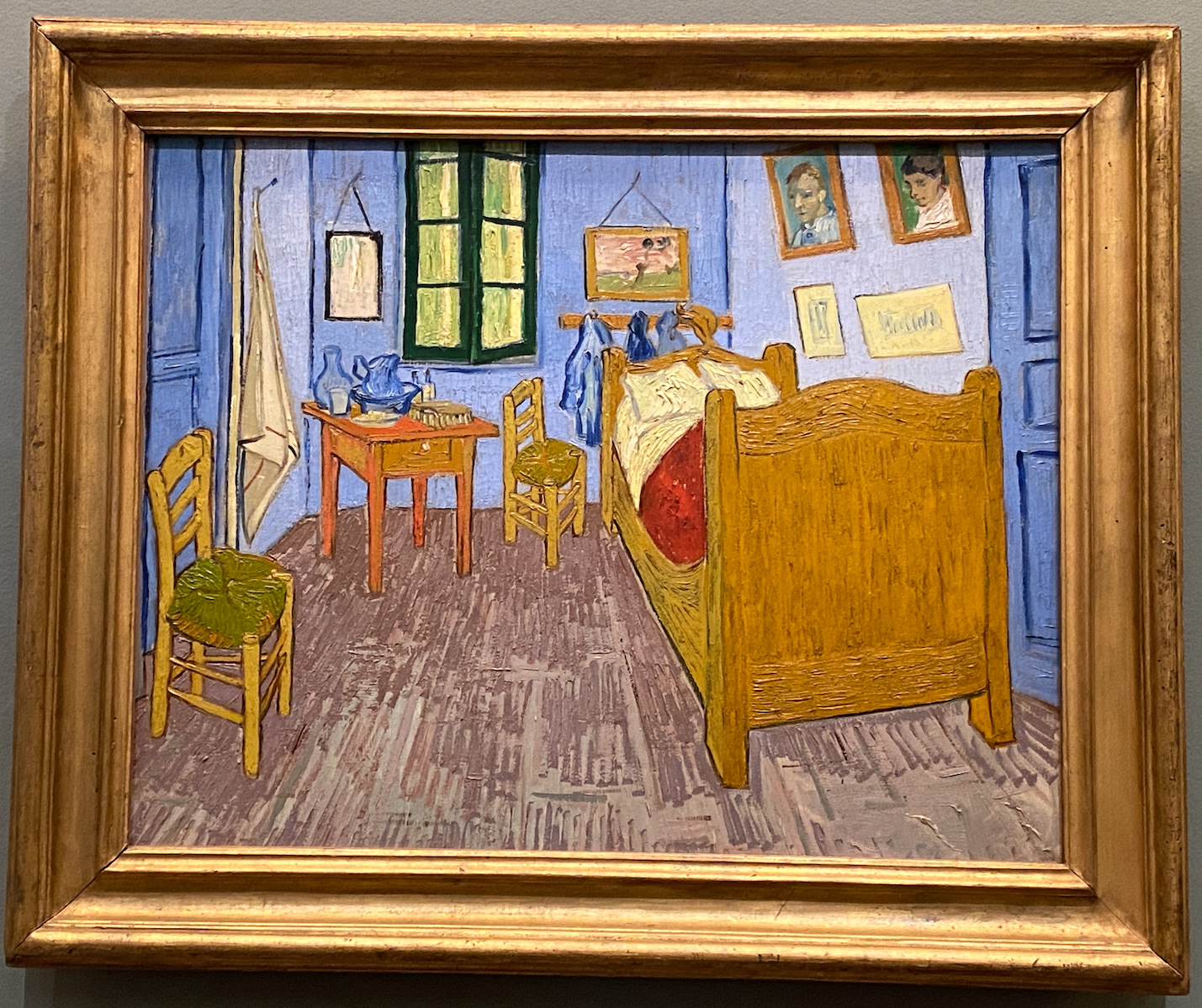
In total 24 Van Gogh’s are in the Orsay.
Claude Monet – (1840-1926)
The father of impressionism, Monet is perhaps best known for his later works of water lilies from his pond at his house in Giverny. They occupied the last 20 years of his life as he felt his garden was his ‘finest masterpiece’.
The Orsay has 86 of his works, which is the largest assembled collection outside of the Musée Marmottan Monet, also in Paris.
Blue Water Lilies
Painted between 1916-1919, this is only one of many such paintings depicting the pond he established in his garden at Giverny. This painting concentrates on one particular area and shows how Monet’s style became much more loose and freer than in his early works.
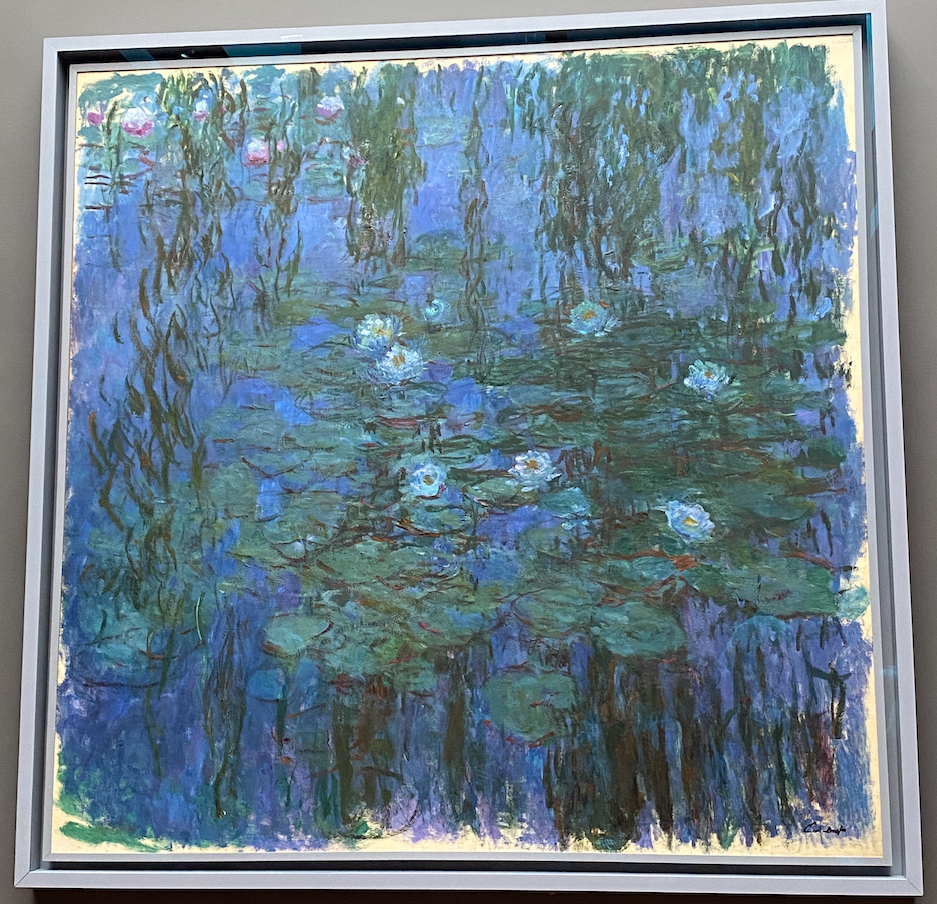
Water Lily Pond – Green Harmony
Painted in 1899, the Japanese bridge in his garden is the focal point of the painting, where no sky is featured, but the brush strokes skilfully define the pond lilies and the areas of water reflection.
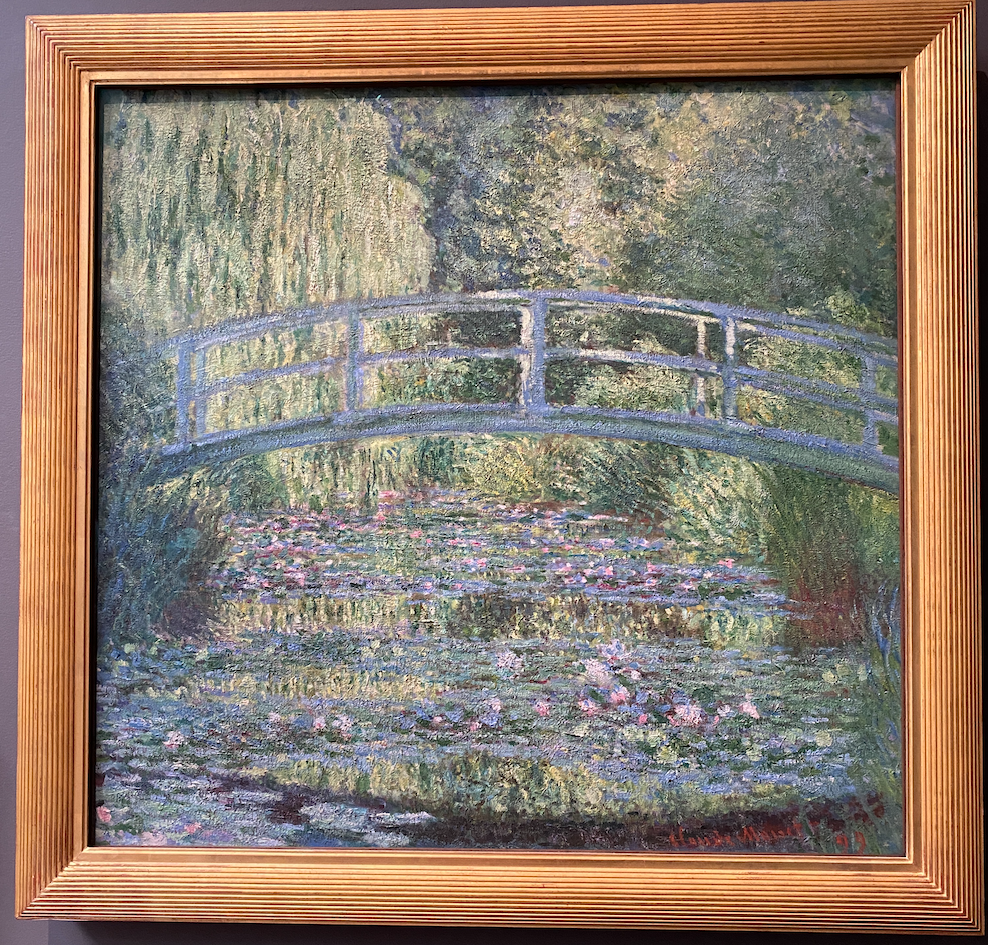
Luncheon on the Grass – (Le Déjeuner sur l'herbe)
Painted in 1865-66 it is an unfinished work but two fragments, made up of the left and centre panels, now hang in the Orsay. A smaller version of the complete painting is in the Pushkin Museum in Moscow.
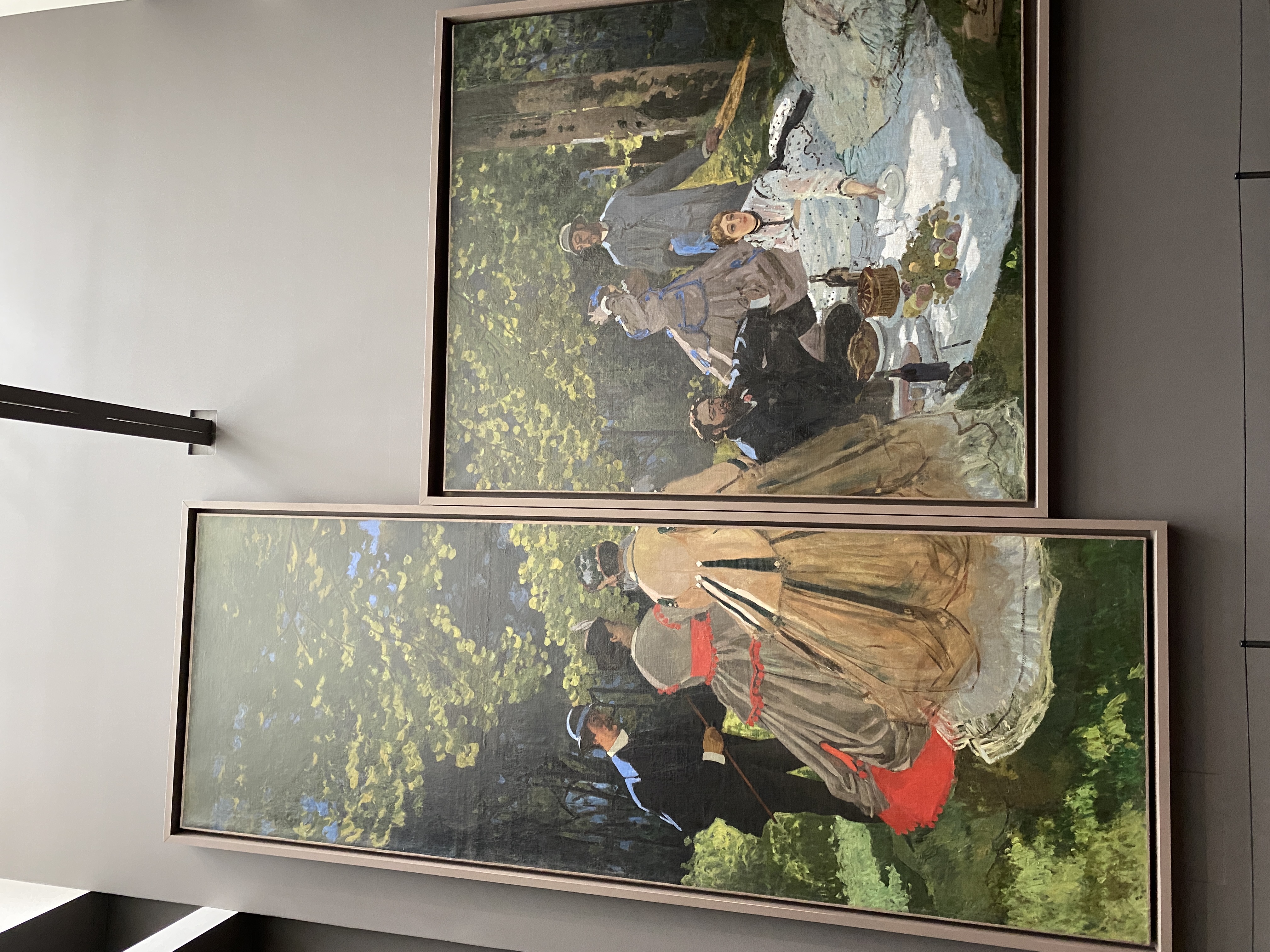
Pierre-Auguste Renoir (1841-1919)
The Orsay has 81 paintings by Renoir, who was also an impressionist like Monet.
Dance at the Moulin de la Galette
This piece is one on Renoir’s most celebrated, depicting a Sunday afternoon in Montmartre. Painted in 1876, a smaller version of it also exists (said to be in the hands of a Swiss private collector).
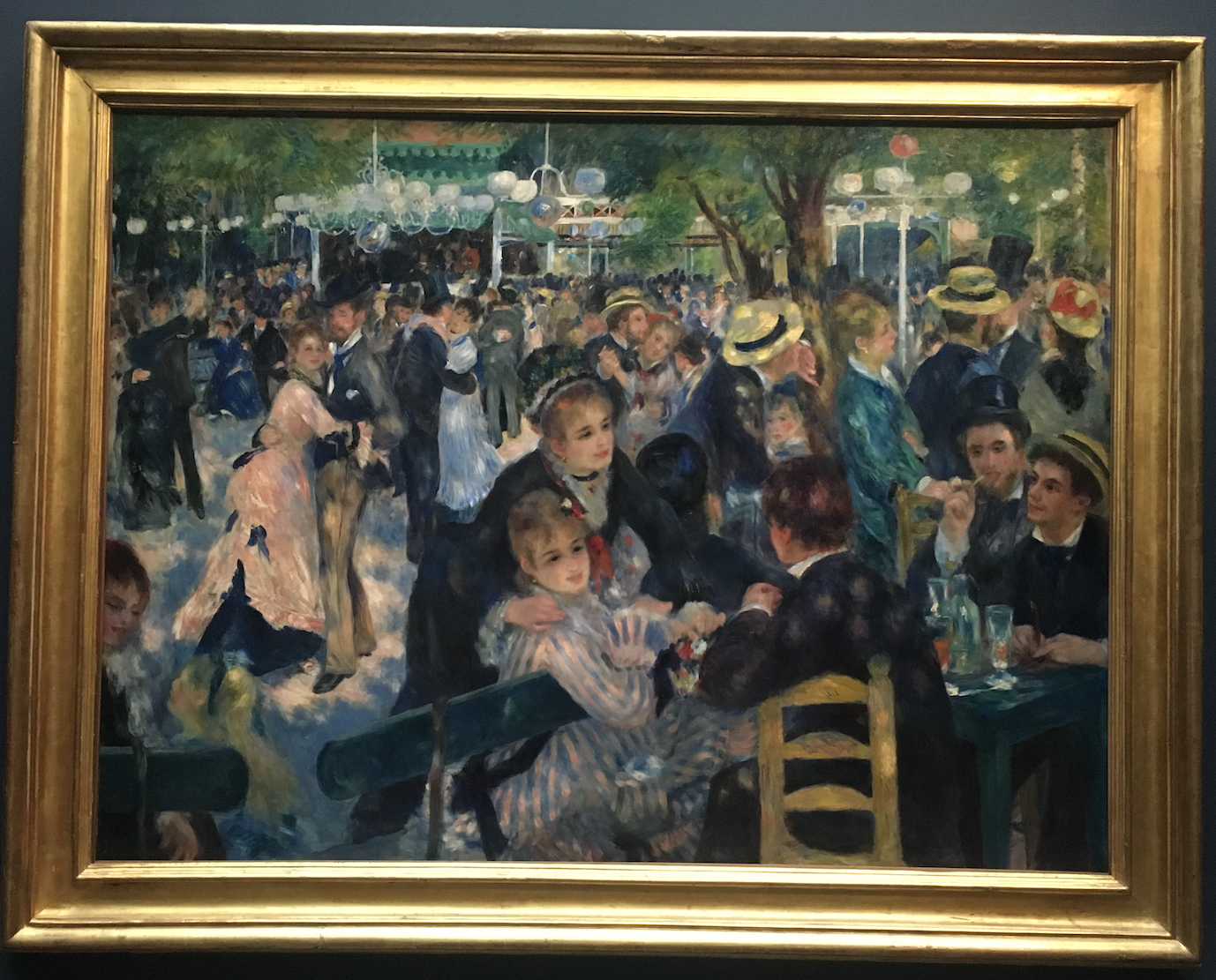
City Dance & Country Dance
These two paintings were designed as companion pieces, having both been painted in 1883.
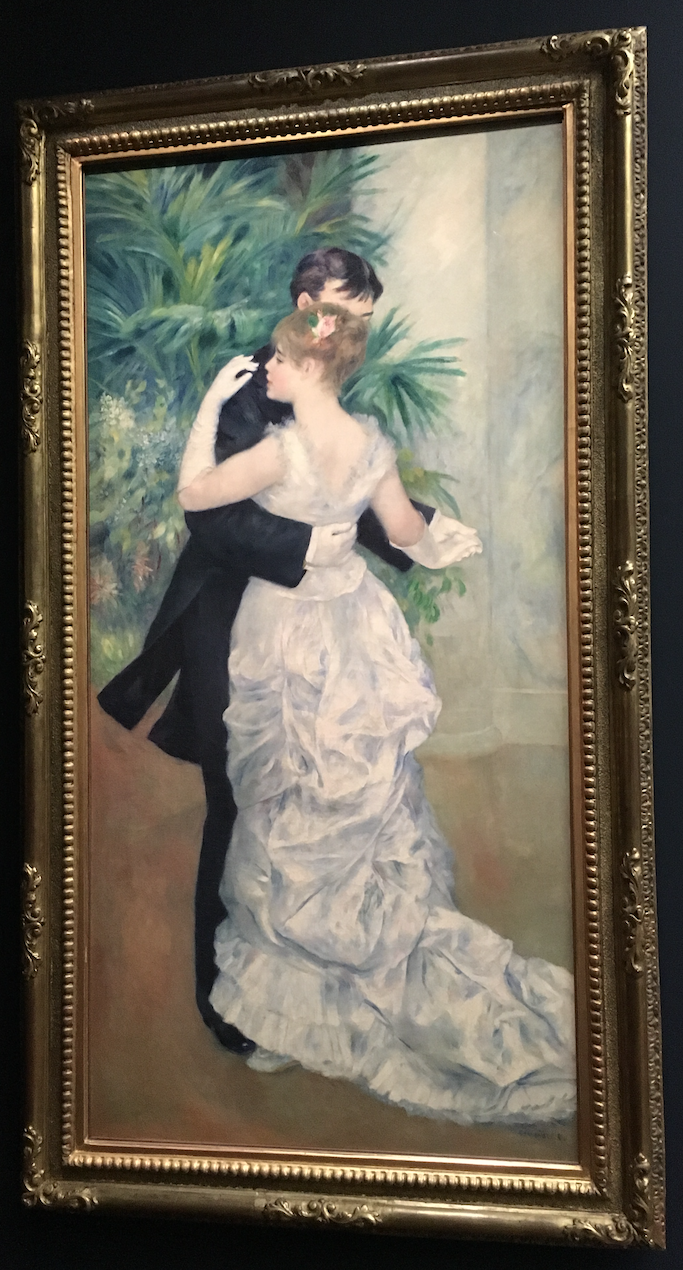
The woman depicted in the red hat in ‘Dance in the Country’ was Aline Charigot, who later became Renoir’s wife.
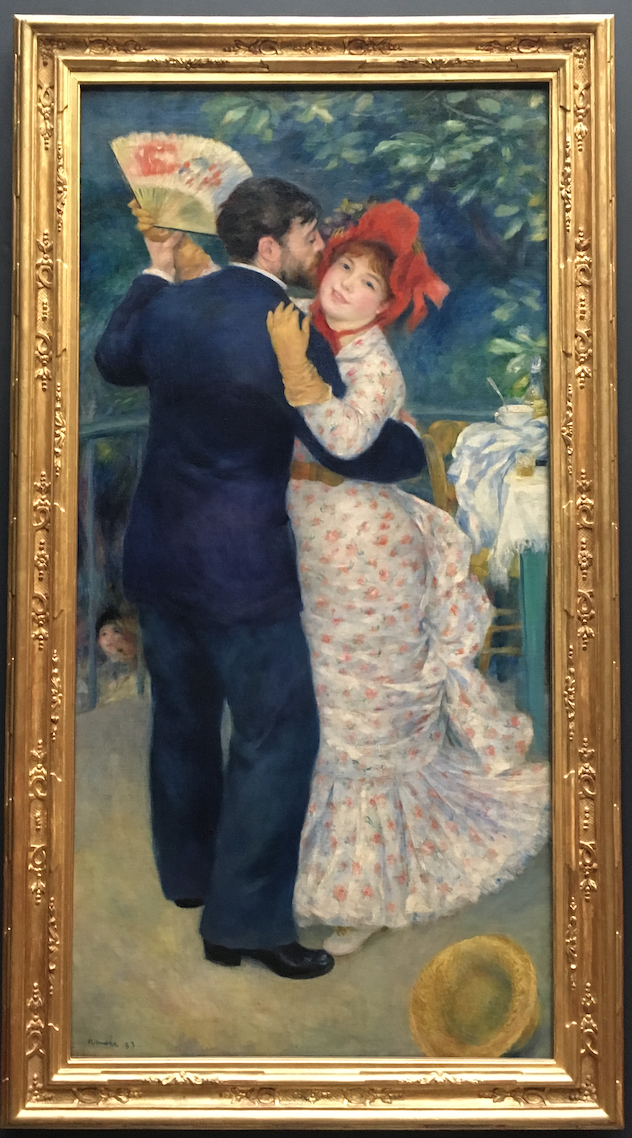
Edgar Degas – (1834-1917)
Degas is famous for his pastel drawings and oil paintings and in my mind, ballerinas.
The Orsay has several of his works, like that below of ‘The Dance Class’
Begun in 1873 but not finished until 1876, it is a companion piece of a work under the same name which is now in The Met in New York City.
From the early 1870s, until he died, ballerinas became his favourite subject, whether they were dancing, exercising, rehearsing or resting.
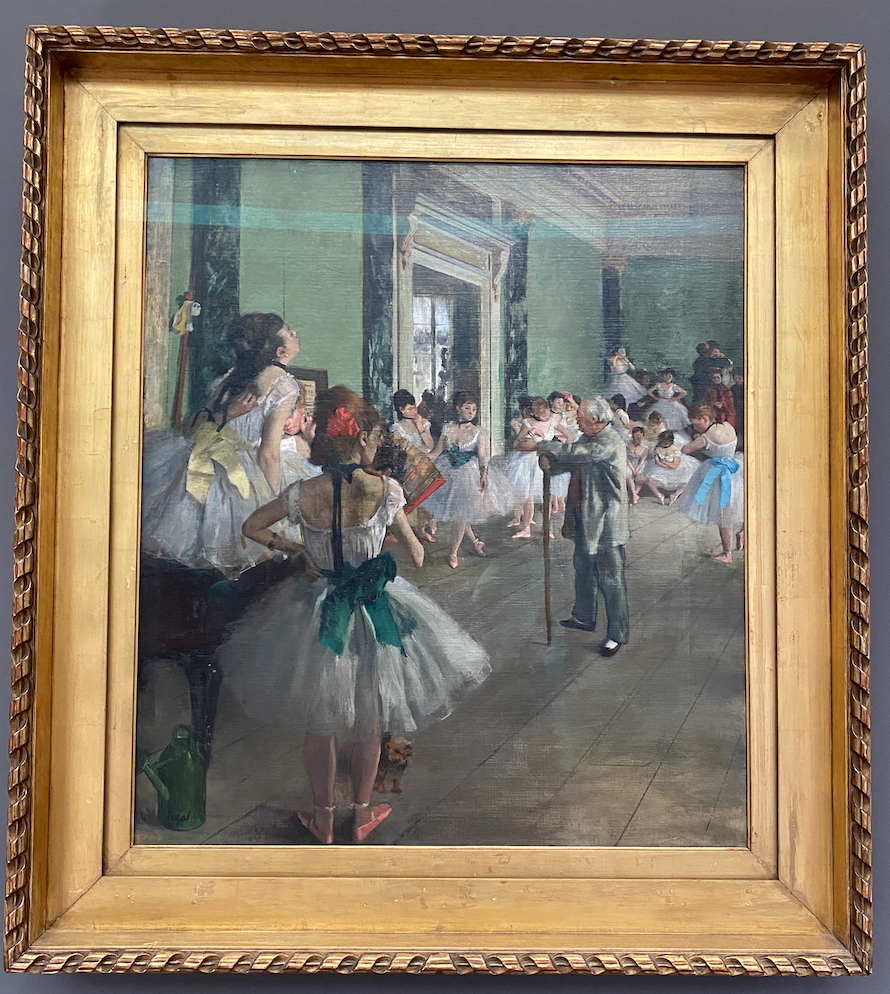
Relevant Information
Full details about visiting the Orsay can be found here:
Tickets can be purchased here and a reserved timeslot needs to be booked.
https://billetterie.musee-orsay.fr/en-GB/products?famille=1933737738230400130
Holders of the Paris Museum Pass do not need to book a time and line up by Entrance C, to gain entry.
A map of the Museum can be found here:
https://www.musee-orsay.fr/sites/default/files/2022-10/PLANGUIDE%20ORSAY%20FAE%20automne22_0.pdf
4. Château De Versailles
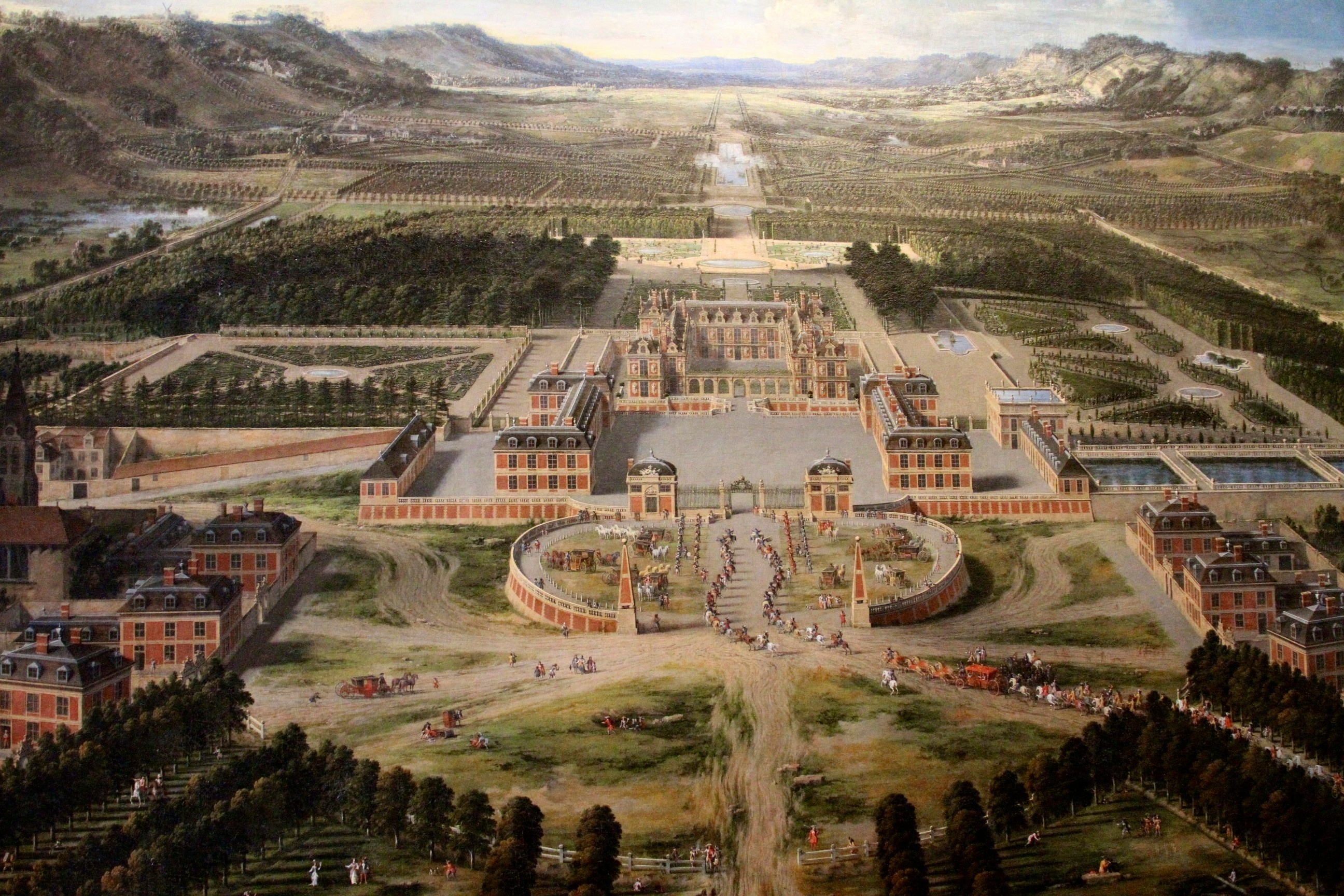
It is not possible to do the Palace of Versailles justice in its own single issue, let alone as a place to visit in the Top 5 of things to do in Paris but I will give you a small taste today to encourage you to visit it the next time you are in France.
Located just over an hour from Paris by train, you will need to allow a whole day to tour the palace and gardens.
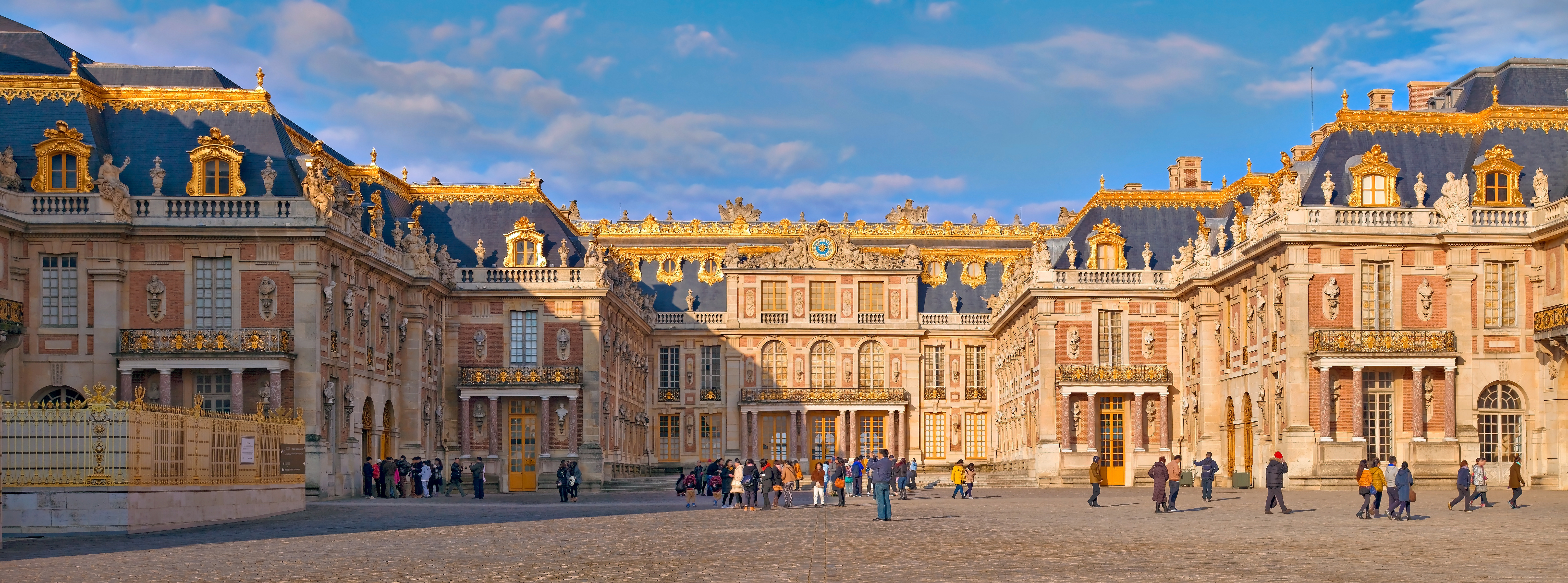
History
Originally the site of a hunting lodge, built by Louis XIII, Versailles was expanded into a chateau by Louis XIV after 1661. Construction first concentrated on the parks and gardens (which are so extensive they offer bike and golf cart hire to enable you to see them properly) and extended the buildings his father started with expansion taking place between 1668-1671.
In 1670 the King’s architect was tasked with creating a city of Versailles, around the palace, to accommodate the growing government and court. In 1672 the Franco-Dutch War meant worked stopped as funds were needed to fight the war effort, but victory in 1678 meant the king was able to continue his plans with increased vigour and expense.
Versailles was abandoned after the death of Louis XIV in 1715, and it was not until 1722 that Louis XV returned and decided to make some smaller intimate spaces in the palace as he didn’t like the larger state rooms.
In 1770 Louis XVI was married at Versailles and he and Marie-Antoinette set up their court here, spending most of their time out of Paris. Louis gave her the Petit Trianon as her private domain.
The palace came through the French Revolution relatively unscathed (although most of the furniture was auctioned off) and in 1789, the ‘court’ left it for Paris, never to return.
In 1833 King Louis-Phillippe decided to turn it into a “museum dedicated to all the glories of France”, and it opened as such in 1837.
Versailles was used to negotiate (and sign) the WWI peace treaty and it was noticeable at this time that it had become tired and worn out. Its dilapidated condition was rescued by JD Rockefeller, the American billionaire, who gave two large donations to save it.
A more detailed history of Versailles can be found here:
https://en.chateauversailles.fr/discover/history#louis-xiii-and-versailles1607-1638
Hall of Mirrors
In 1681 the Hall of Mirrors was completed. The Treaty of Versailles was signed in this room on June 28, 1919.
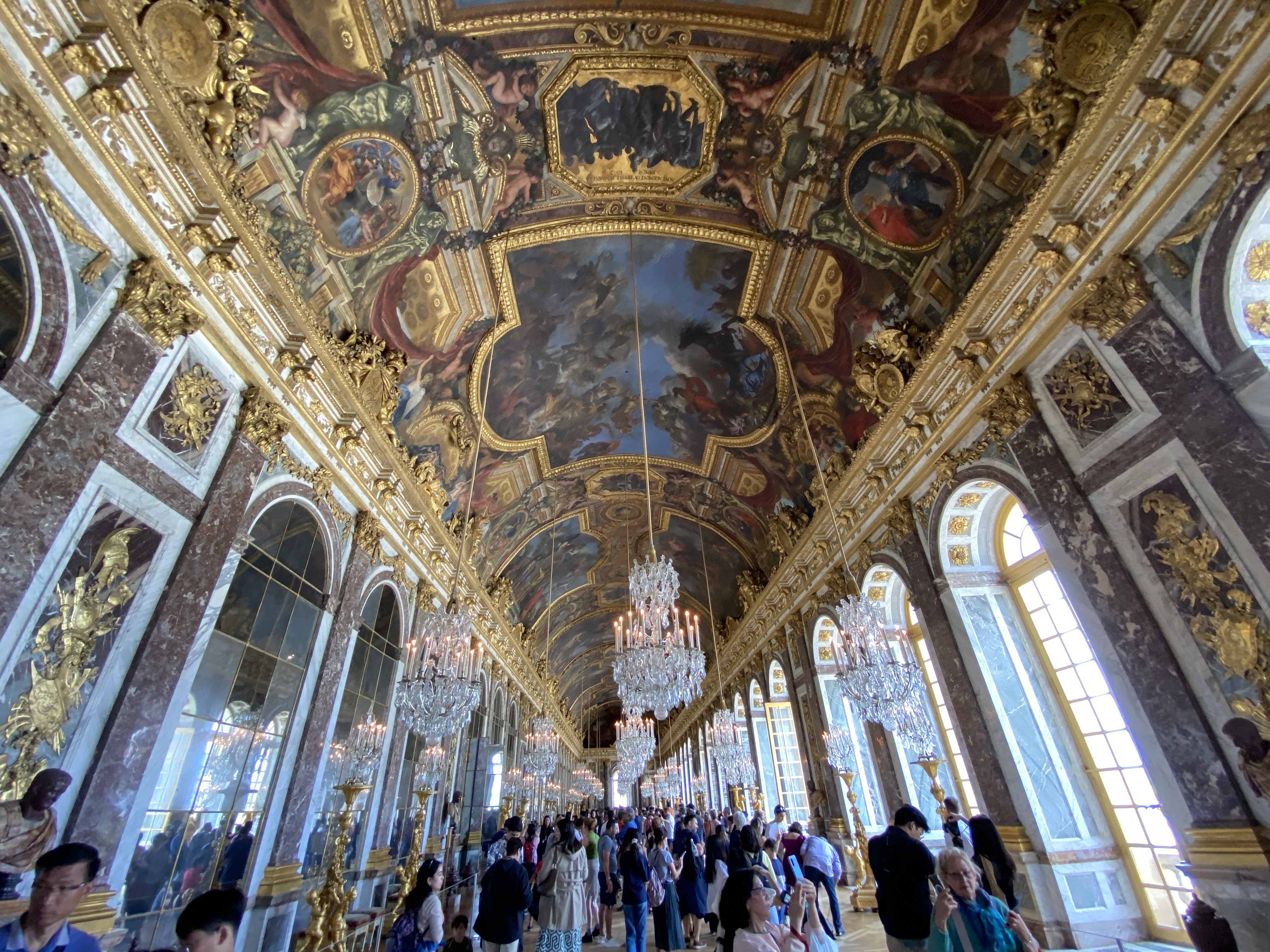
The Chapel Royal
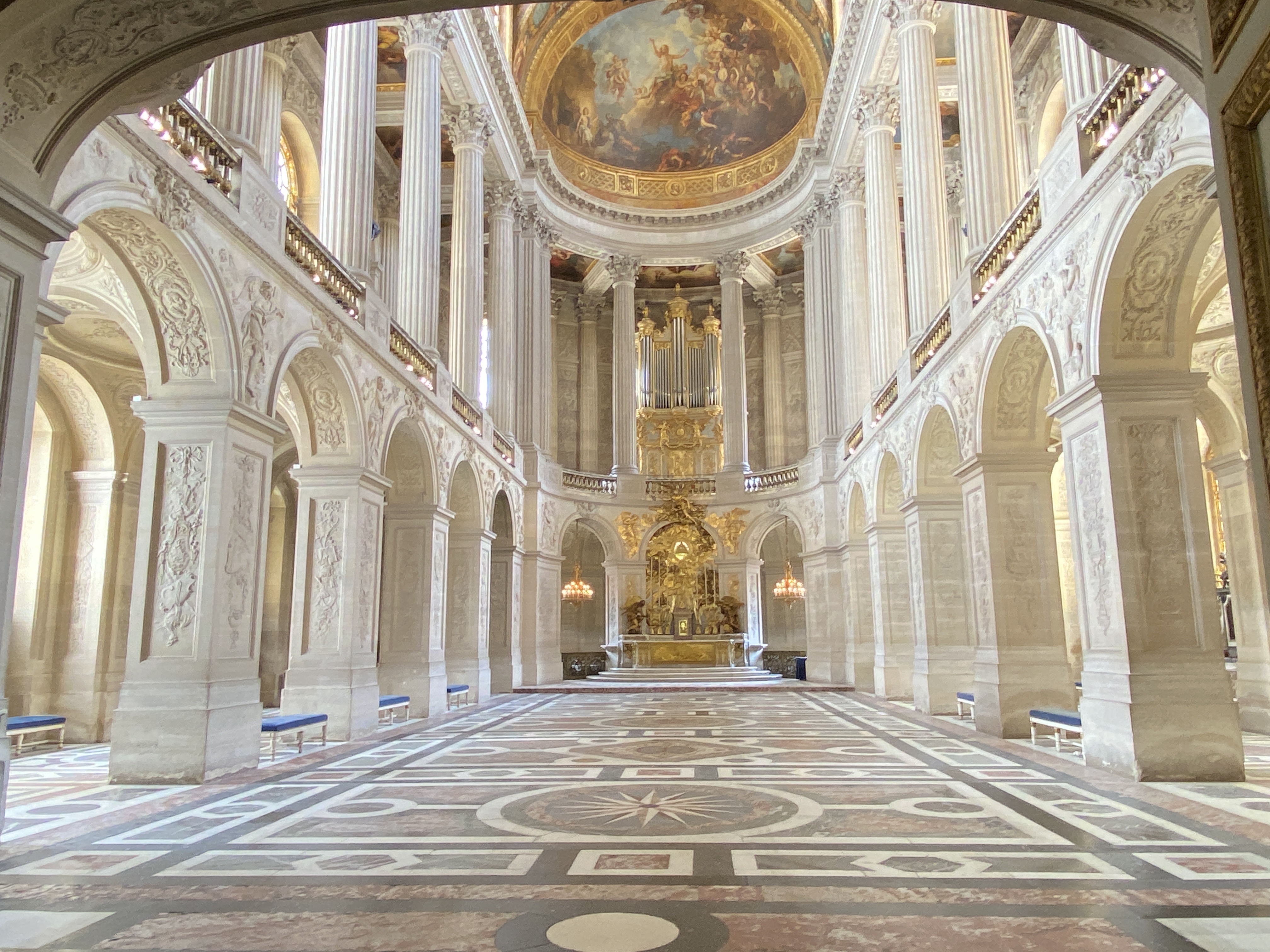
Opened in 1710, Louis XIV and his court attended mass here each day usually at 10am. The royal family sat upstairs in the royal tribune, with the public occupying the side galleries and the nave.
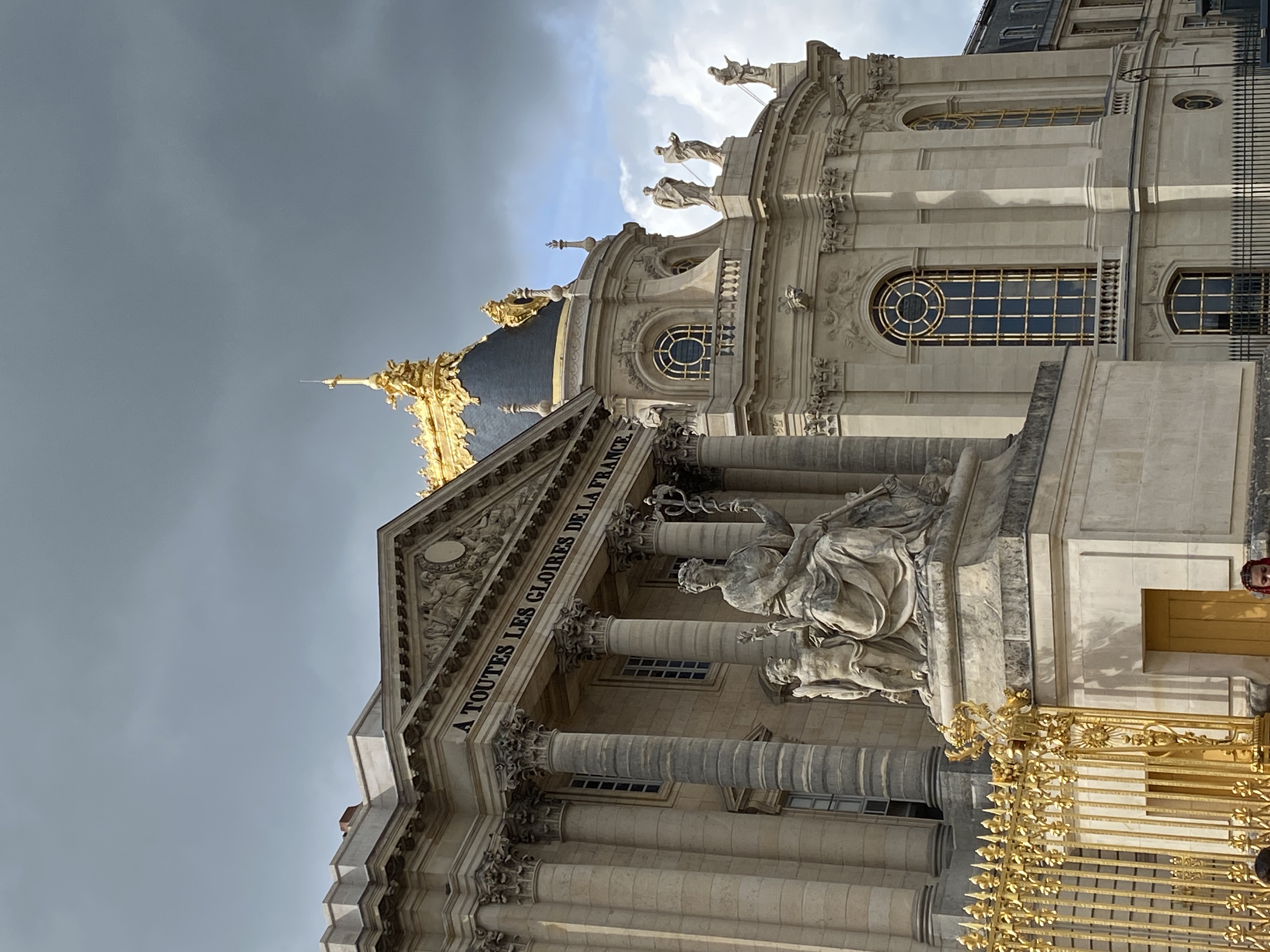
The Battle Gallery
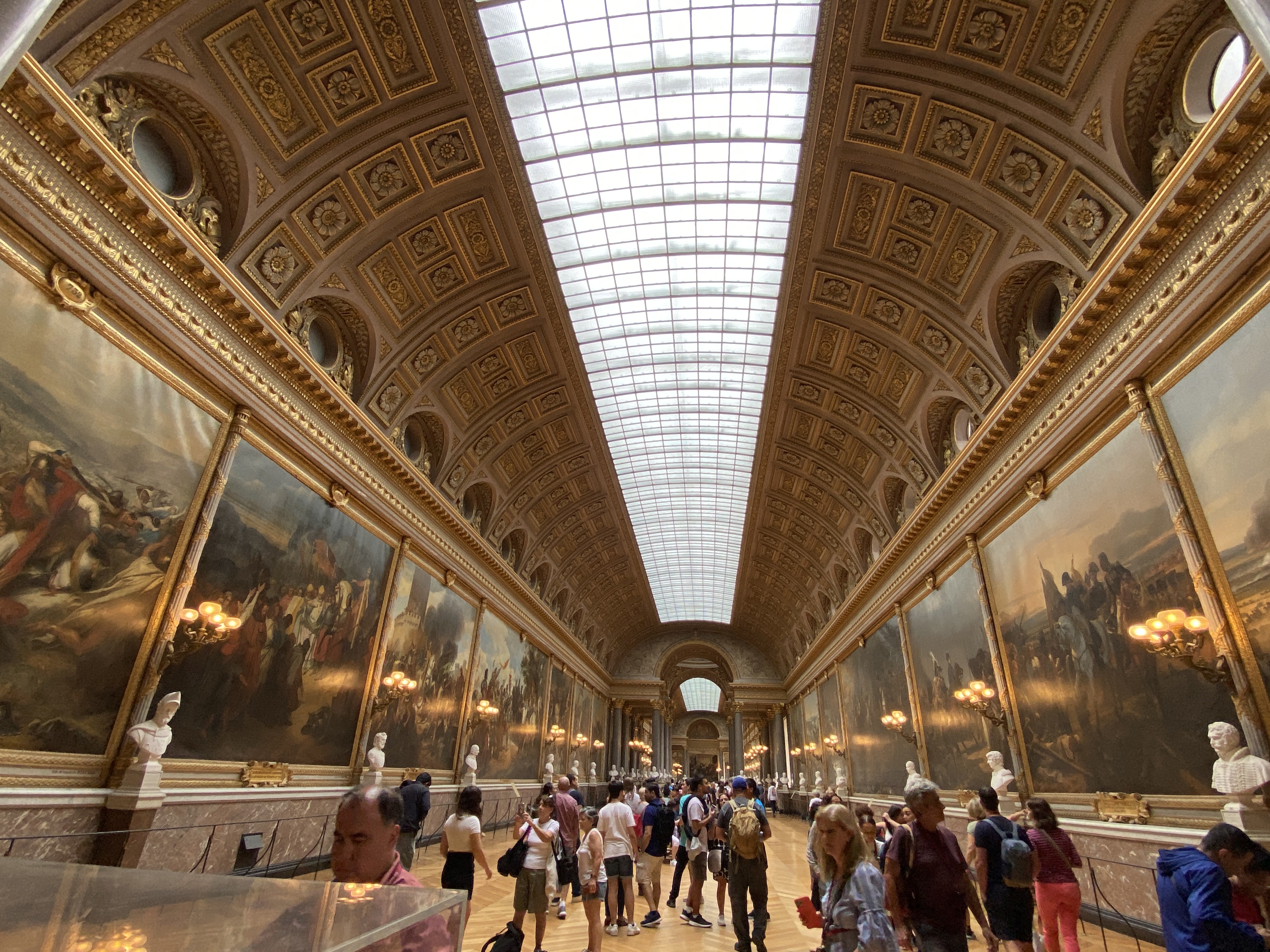
Created in 1837, the gallery measures 120 metres long and occupies most of the south wing.
There are 33 large paintings depicting major victories of the French from Clovis in 496 until Napoleons battle at Wigram in 1809.
The Mercury Salon
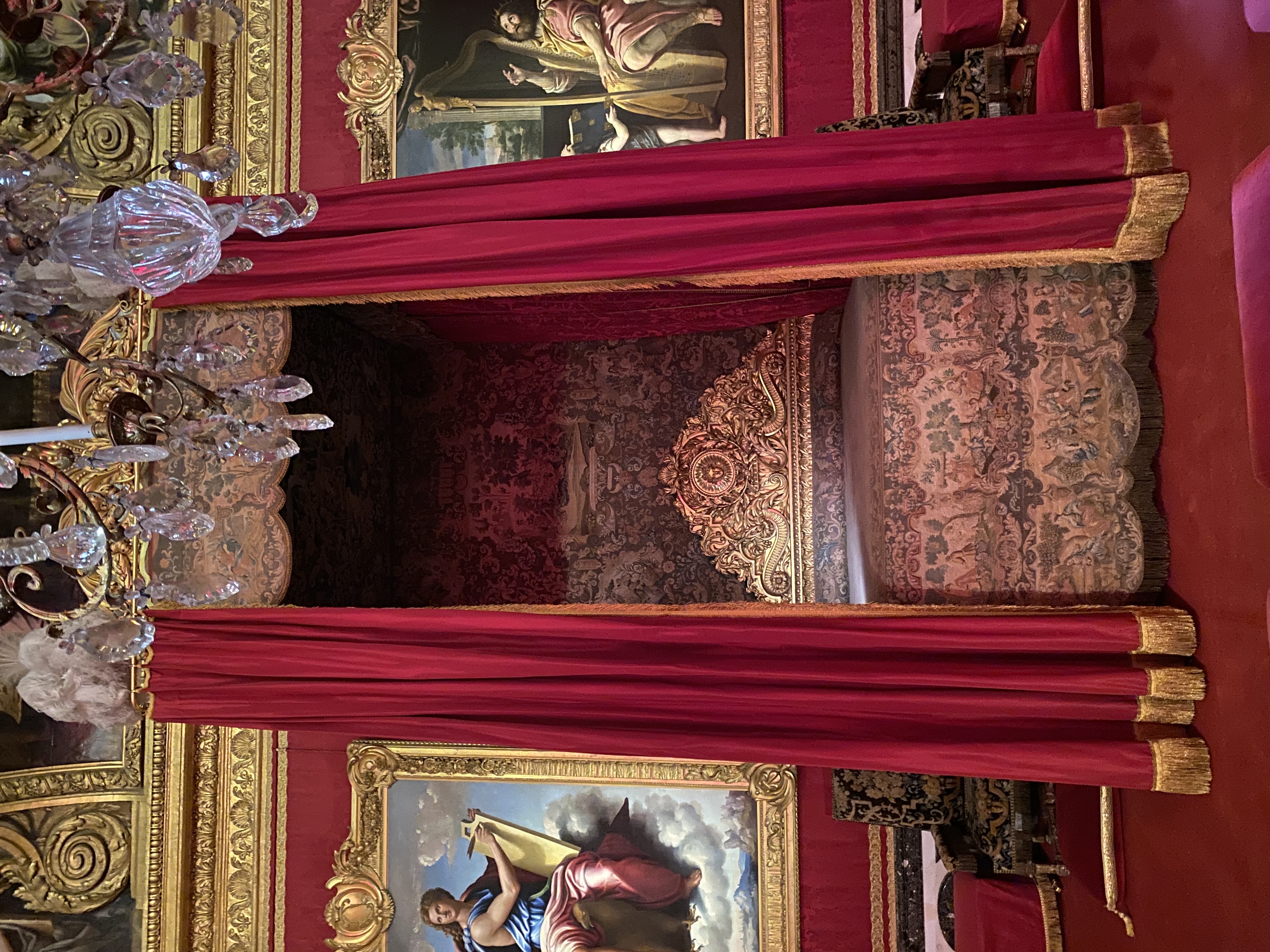
This room, the ceremonial bedchamber of the state apartments, was rarely used for sleeping and in winter the bed was removed to make room for game tables for entertainment.
The Queen’s Bedchamber
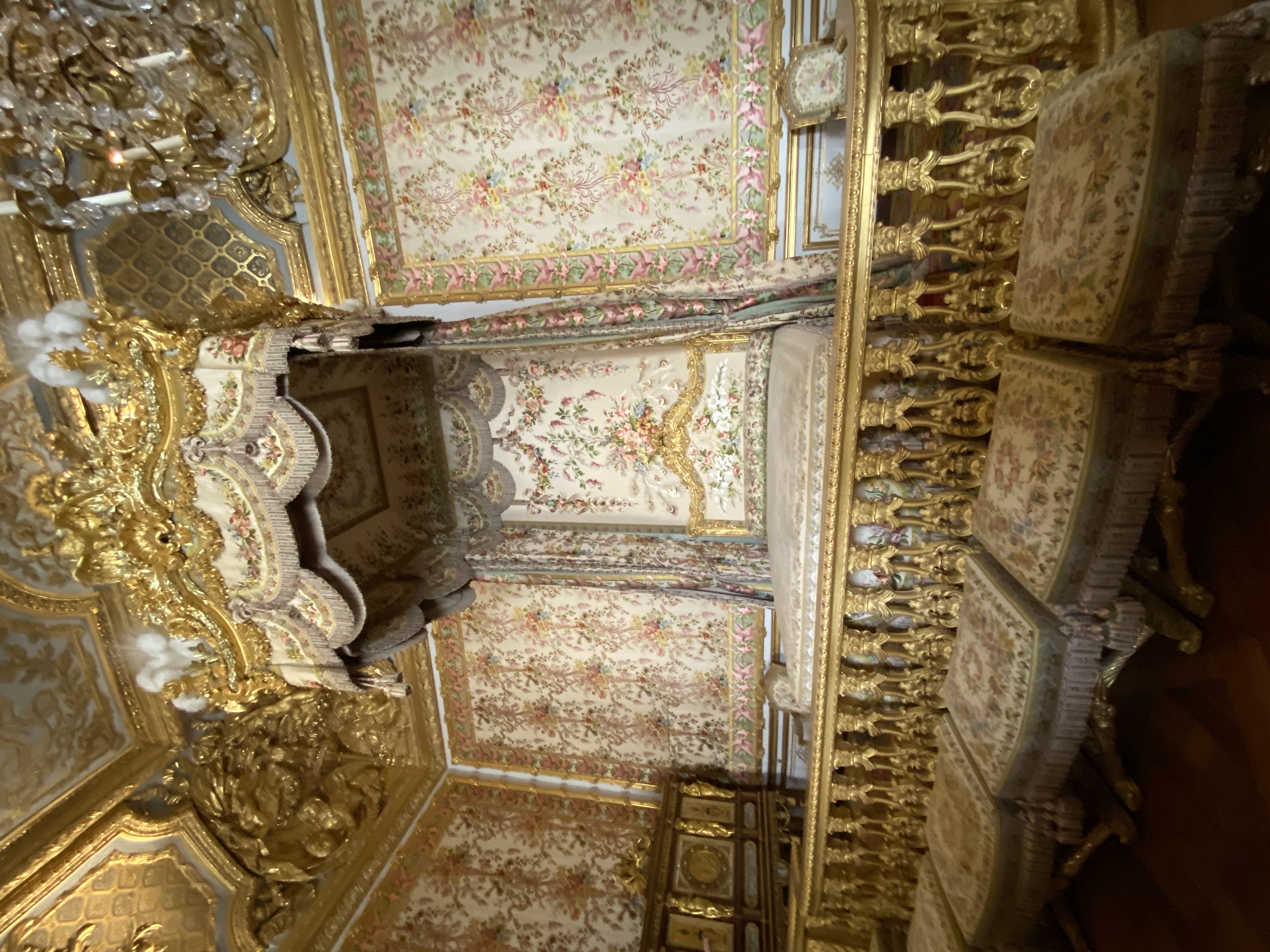
The Queen spent most of her time in this room, sleeping there and often being joined by the king. Occupied by three queens over the life of the palace it was where all royal births took place. In total 19 ‘children of France’ were born in this room.
While not original, the furniture in this room has been replicated based on old documents and paintings from the time.
The Gardens
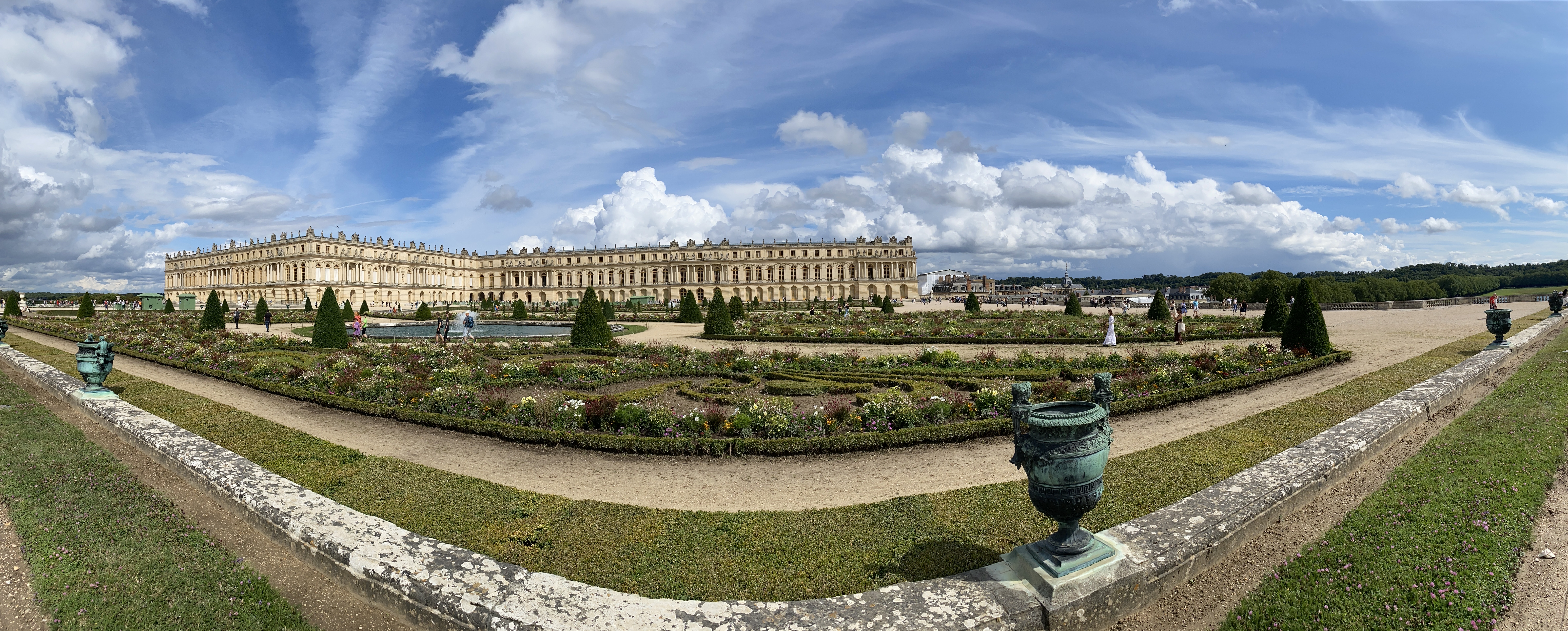
The extensive gardens once occupied over 37,000 acres (150km2) but are now an area covering 2,000 acres (8 km2). Created between 1660-1680 the designer, André Le Nôtre drew on an Apollonian myth theme.
Close to the palace lay formal flower beds, designed to draw the visitors eye from inside to outside.
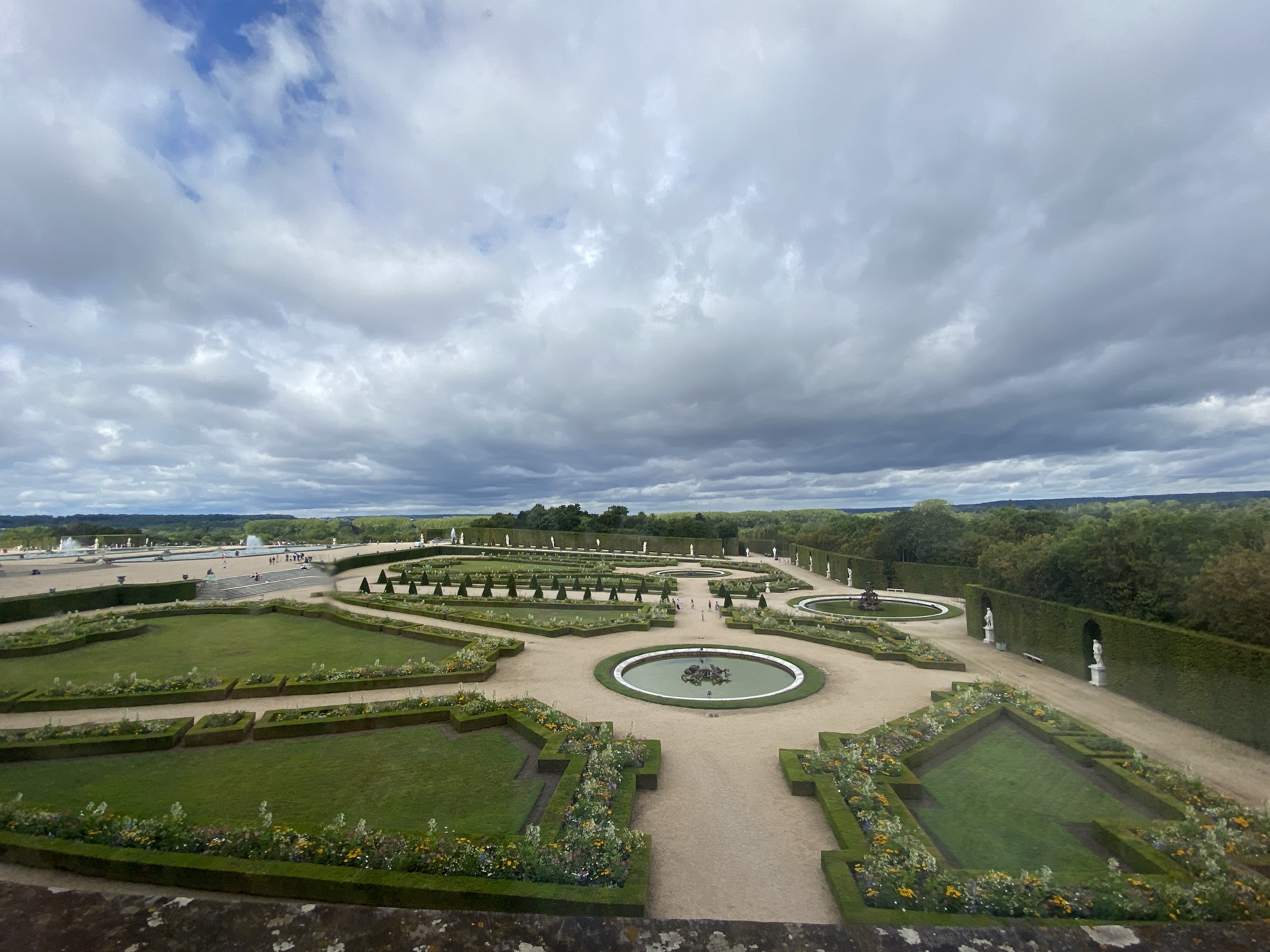
It is almost impossible to describe how incredible and exquisite the gardens at Versailles are but here are a few highlights (and we did not see everything!).
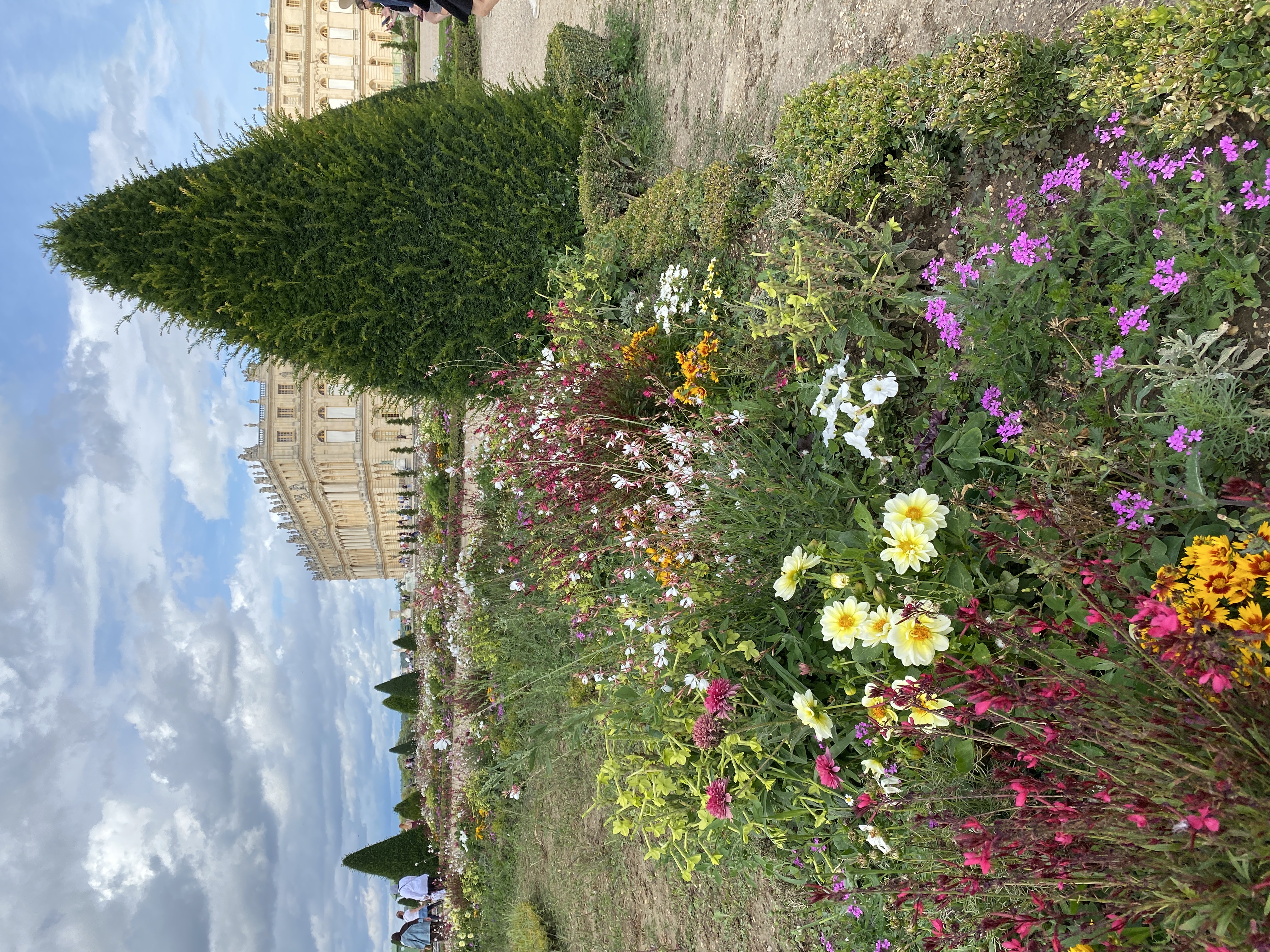
The Orangery
Built between 1684 and 1686 this area of garden is flanked by two side galleries that are used to house the 1,055 trees in tubs (some shown in the photo below) during the winter.
In summer they are kept out on the Orangery Parterre, which extends to 3 hectares. Made up of four areas of lawn and a round pool, on the far side is the ‘Pool of the Swiss’, which was completed in 1688, and covers an area of 16 hectares!
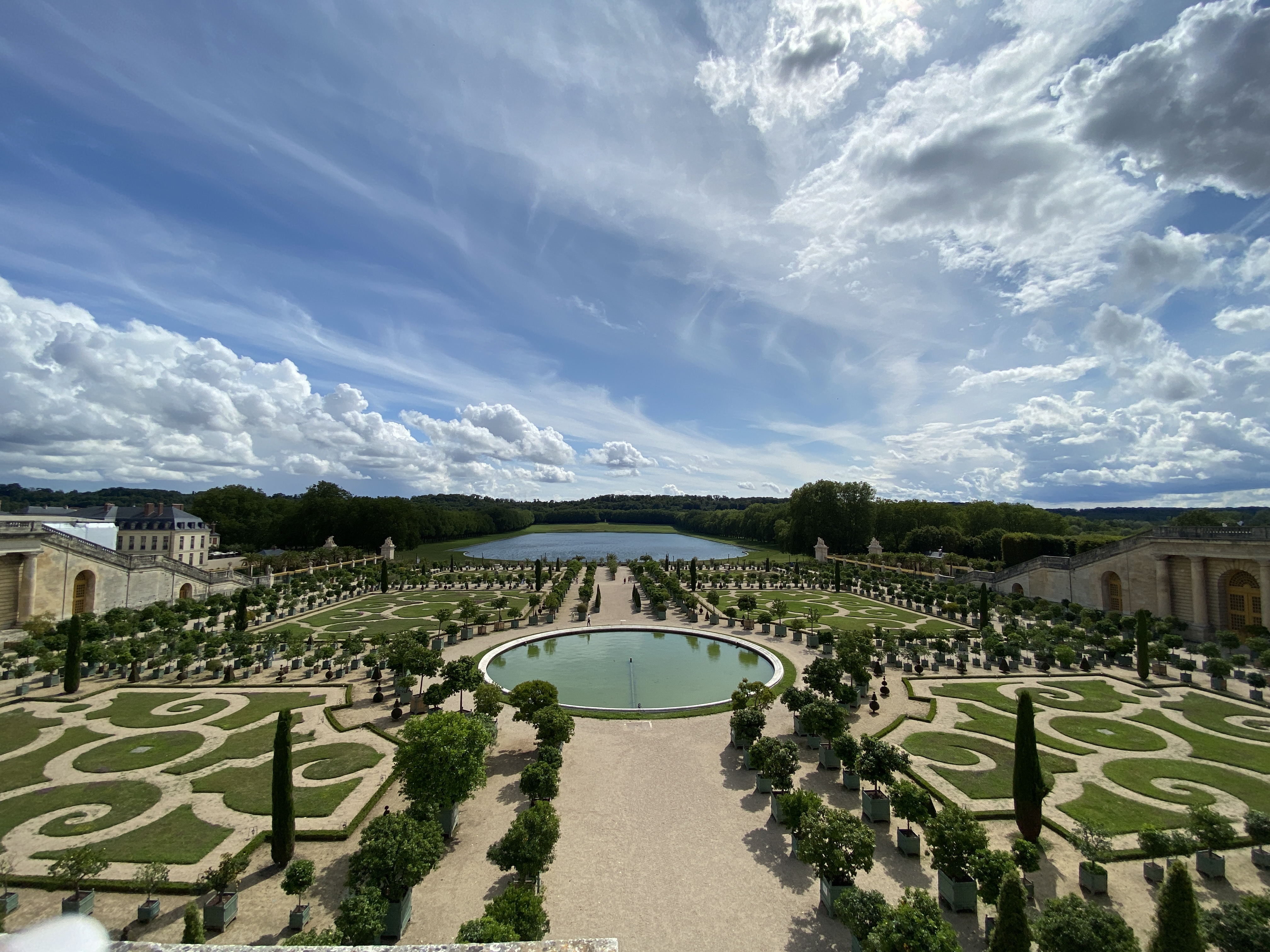
Royal Avenue, The Apollo Basin & the Grand Canal
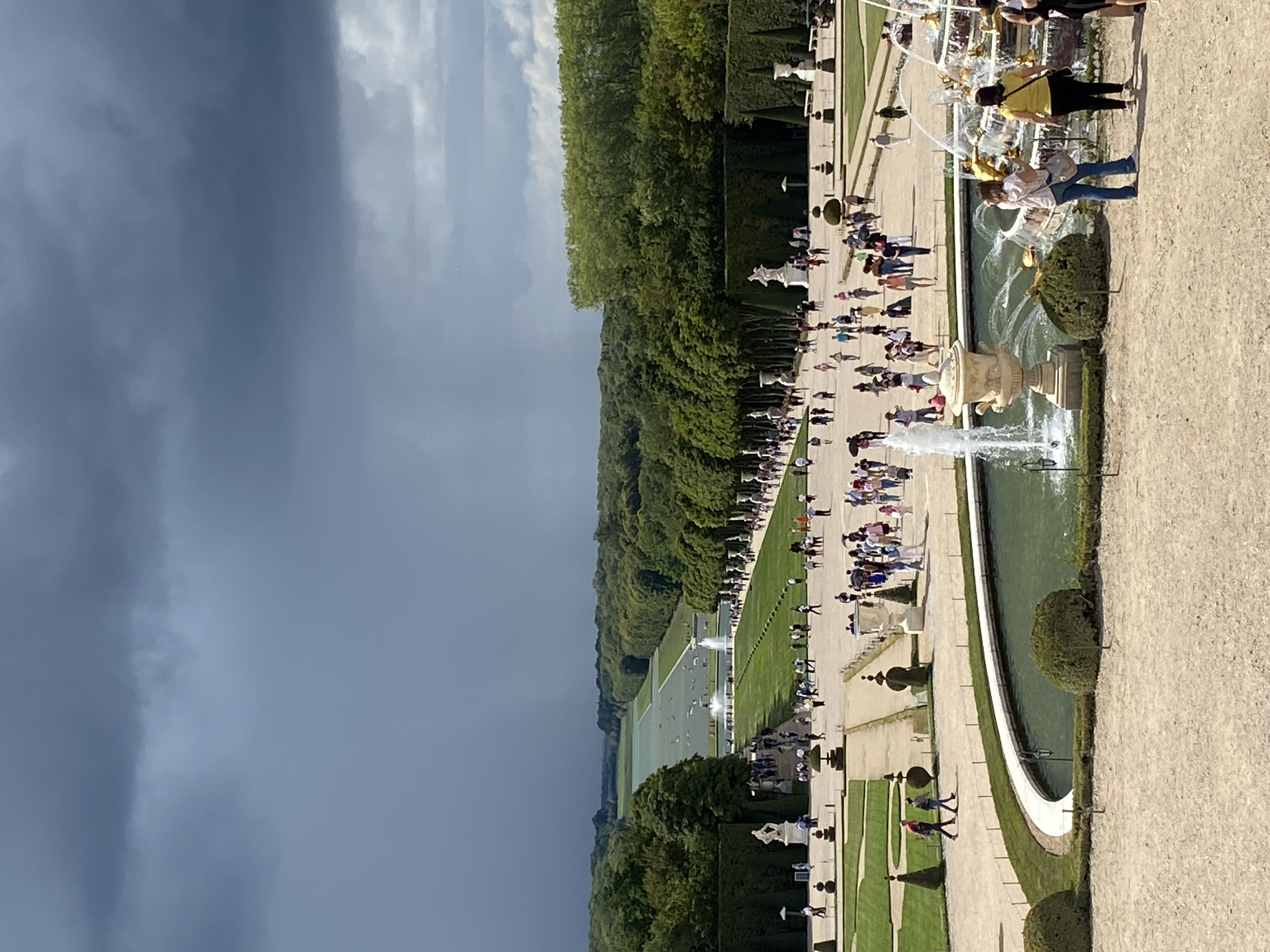
Measuring 330 metres long and 40 metres wide, Royal Avenue (seen here with a large central lawn section), dates back to Louis XIII. Pathways on either side give access to the numerous grottos and the avenue is lined with statues and vases from the 17thC, made by students of the Royal Academy of France in Rome.
The Apollo Basin dated back to 1636 and has a huge statue of Apollo and his horses in it and was created in 1670.
The Grand Canal at the end of the avenue took eleven years to complete. Finished in 1679, numerous water festivals were held there, and Louis XIV had a small flotilla of boats resident in it during his reign.
The Latona Basin
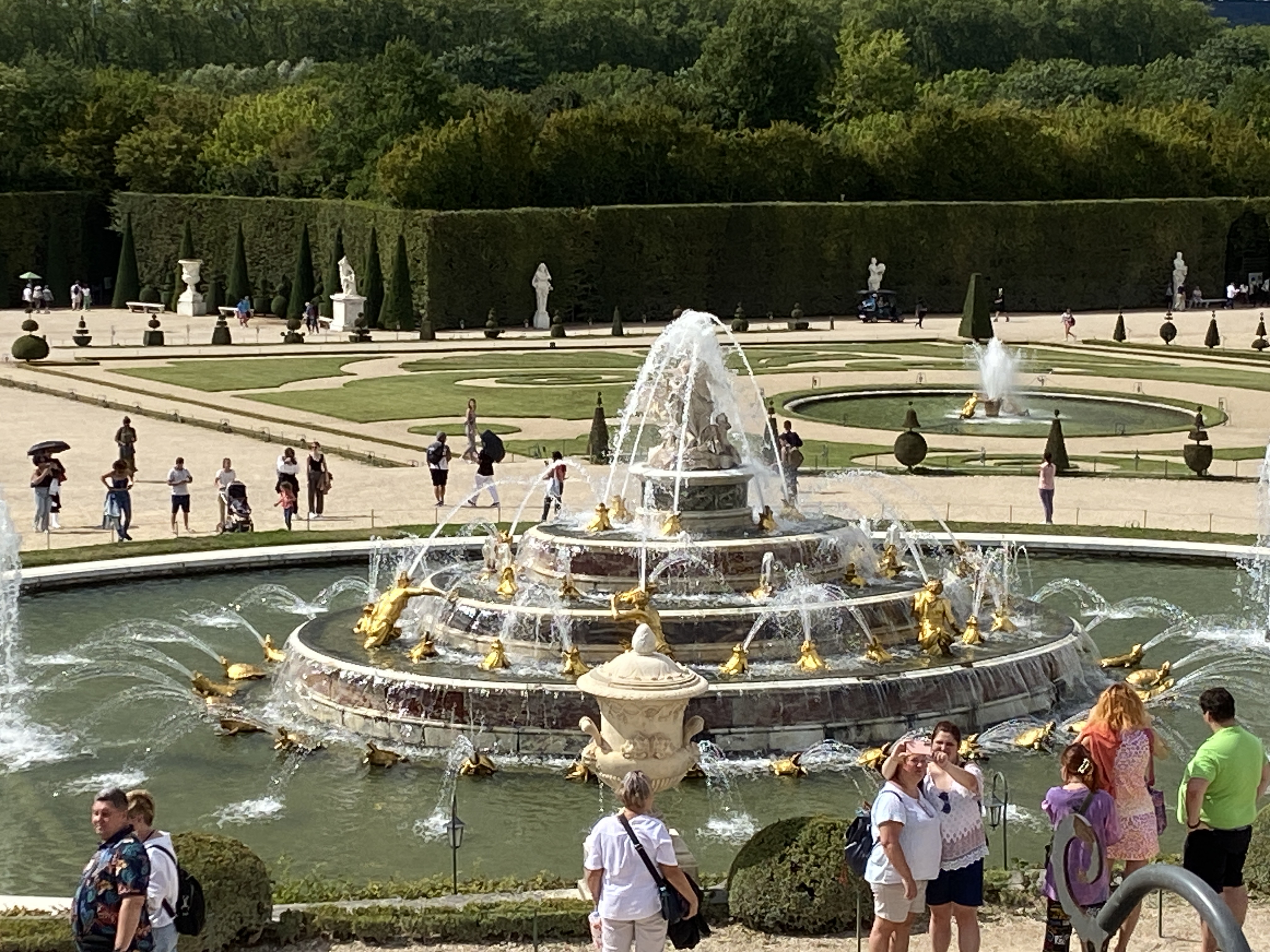
This magnificent fountain, known as the Latona Basin, was inspired by Ovid’s Metamorphoses, illustrating the legend that Apollo’s mother, Diana, is seen protecting her children from insults from the peasants of Lycia, by asked Jupiter to avenge her, which he did by turning them into frogs and lizards (shown in gold in the fountain). Whilst originally placed on a rock, with Diana facing the château, it was upgraded in 1689 and has her now facing the Grand Canal.
Relevant Information
You can learn more about Versailles and how to visit from their website:
https://en.chateauversailles.fr/
Tickets can be purchased here:
https://en.chateauversailles.fr/plan-your-visit/tickets-and-prices
The ‘Passport’ is the best value.
Practical and Useful Information can be found here:
5. Catacombs
https://www.catacombes.paris.fr/en
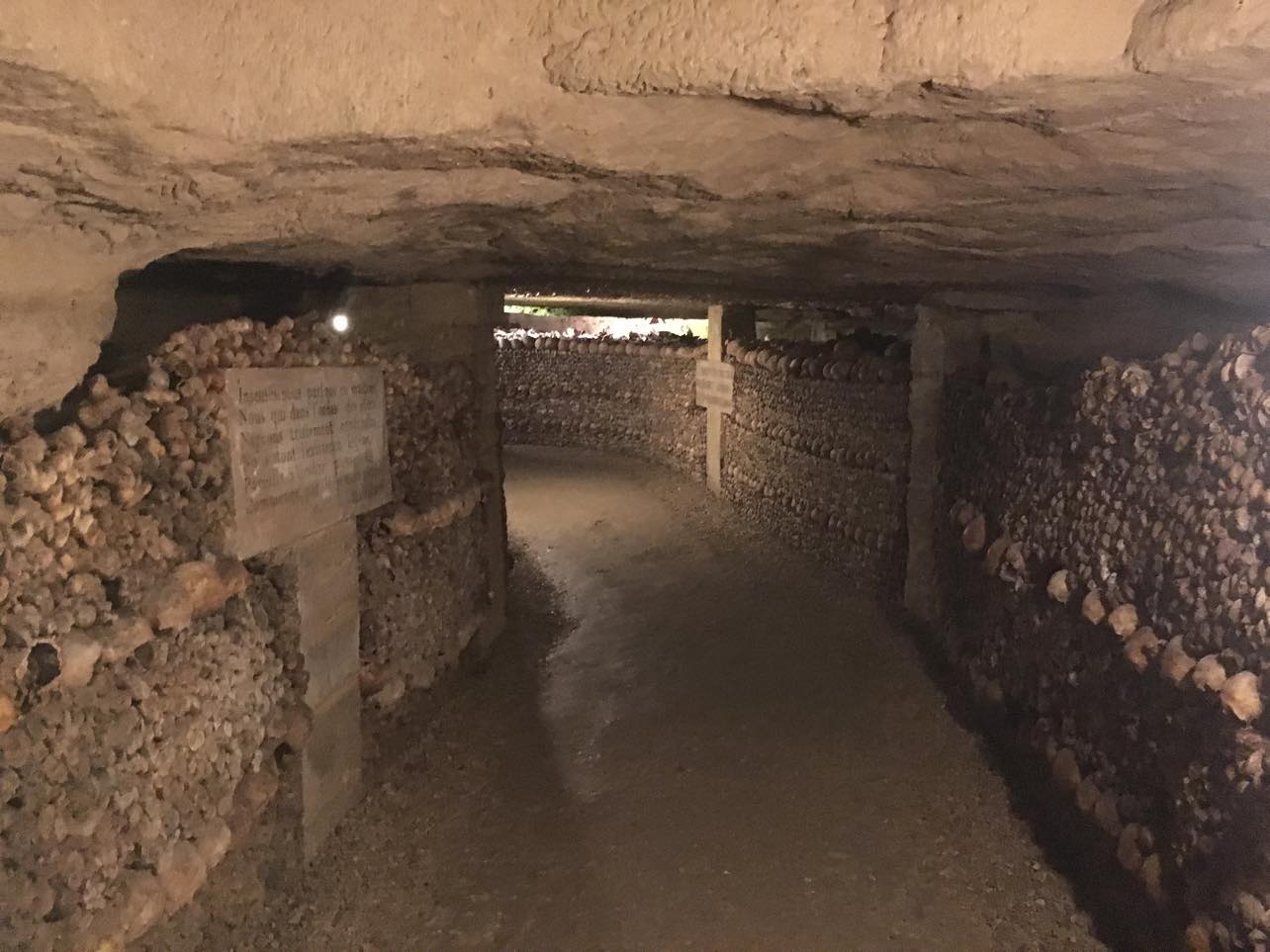
In the late 18thC the city of Paris was faced with major public health issues linked to its local cemeteries. The decision was taken to transfer the remains to an underground site, that was an abandoned quarry.
The first evacuations took place between 1785 to 1787, firstly from the largest cemetery in Paris, Saints-Innocents, which had been in use for nearly ten centuries. The bones were piled into galleries by the quarry workers at night (to avoid hostile crowds) and the transfer continued even after the French Revolution and up until 1814. Resumption of removal started again in 1840 and went until 1860.
From 1786 the consecrated site was called the “Paris Municipal Ossuary’ but took on its current reference name ‘Catacombs’ after the public’s fascination with the Roman ones.
From 1809 it was opened to the public, but the arrangement of the bones undertook a ‘redecoration’ and they were arranged in a more formal manor with bones and skulls laid in pattens.
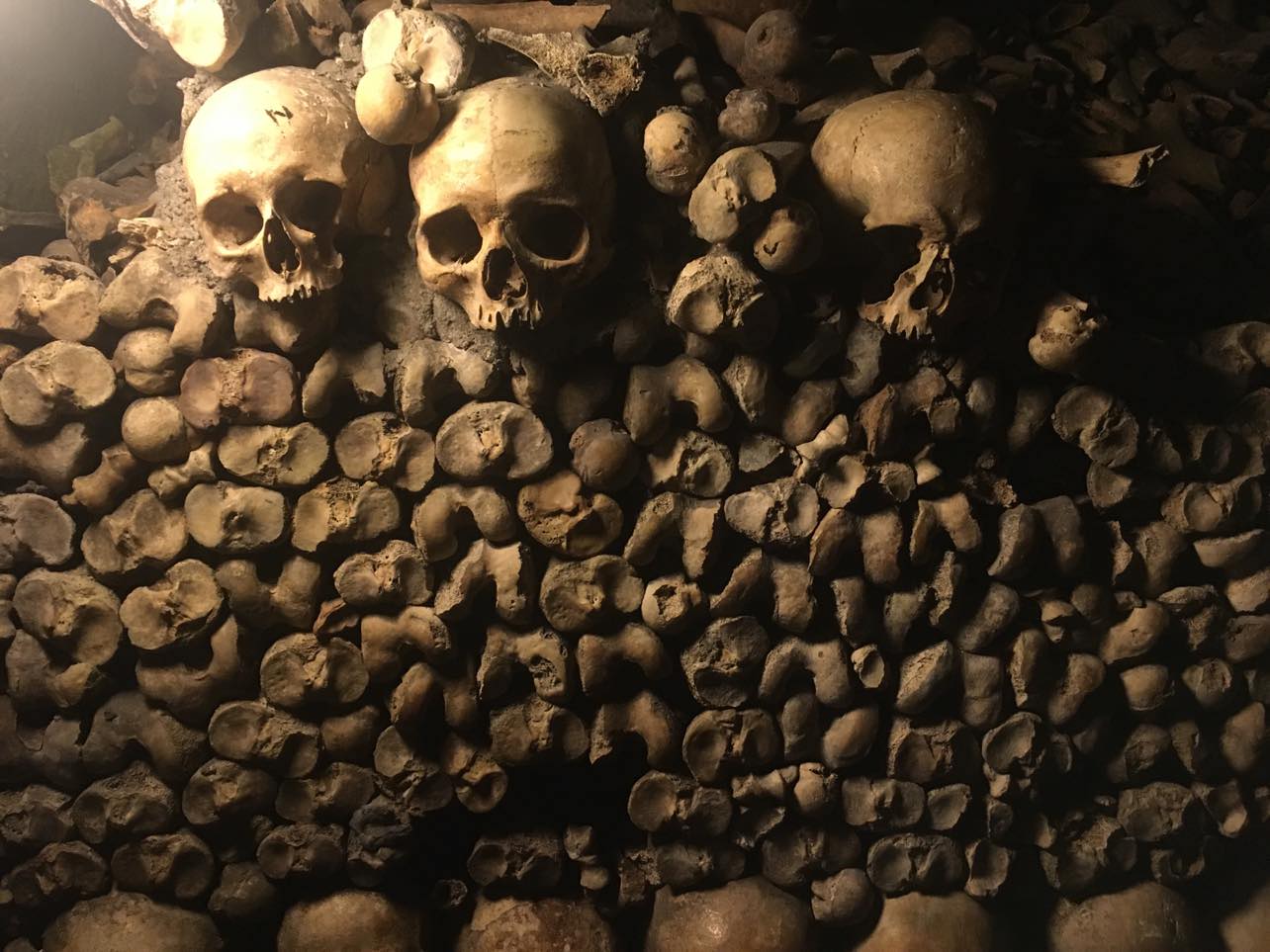
Plaques with sayings and biblical references were added to encourage a more reverent tour of the facilities.
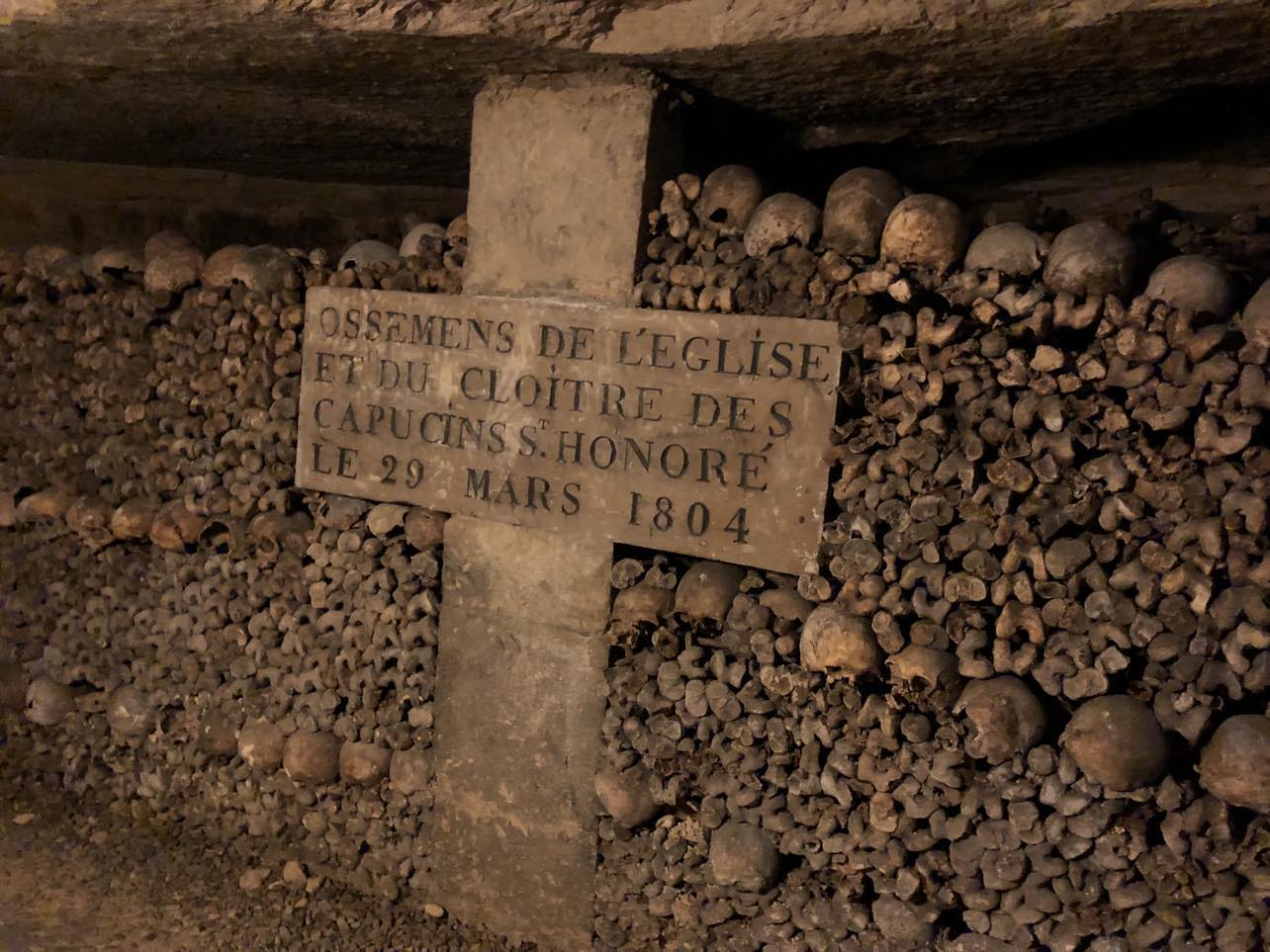
The tunnels extend for 1.5kms and are at a depth of 20 metres underground (roughly a 5-story building), with 131 steps down and 112 up.
A sign at the entrance reads ‘STOP! This is the empire of Death’, so not a place to visit if things like that scare you!
Famous visitors to the site have included, King Charles X of France, Austrian Emperor, Francis I and Napoleon III with his son.
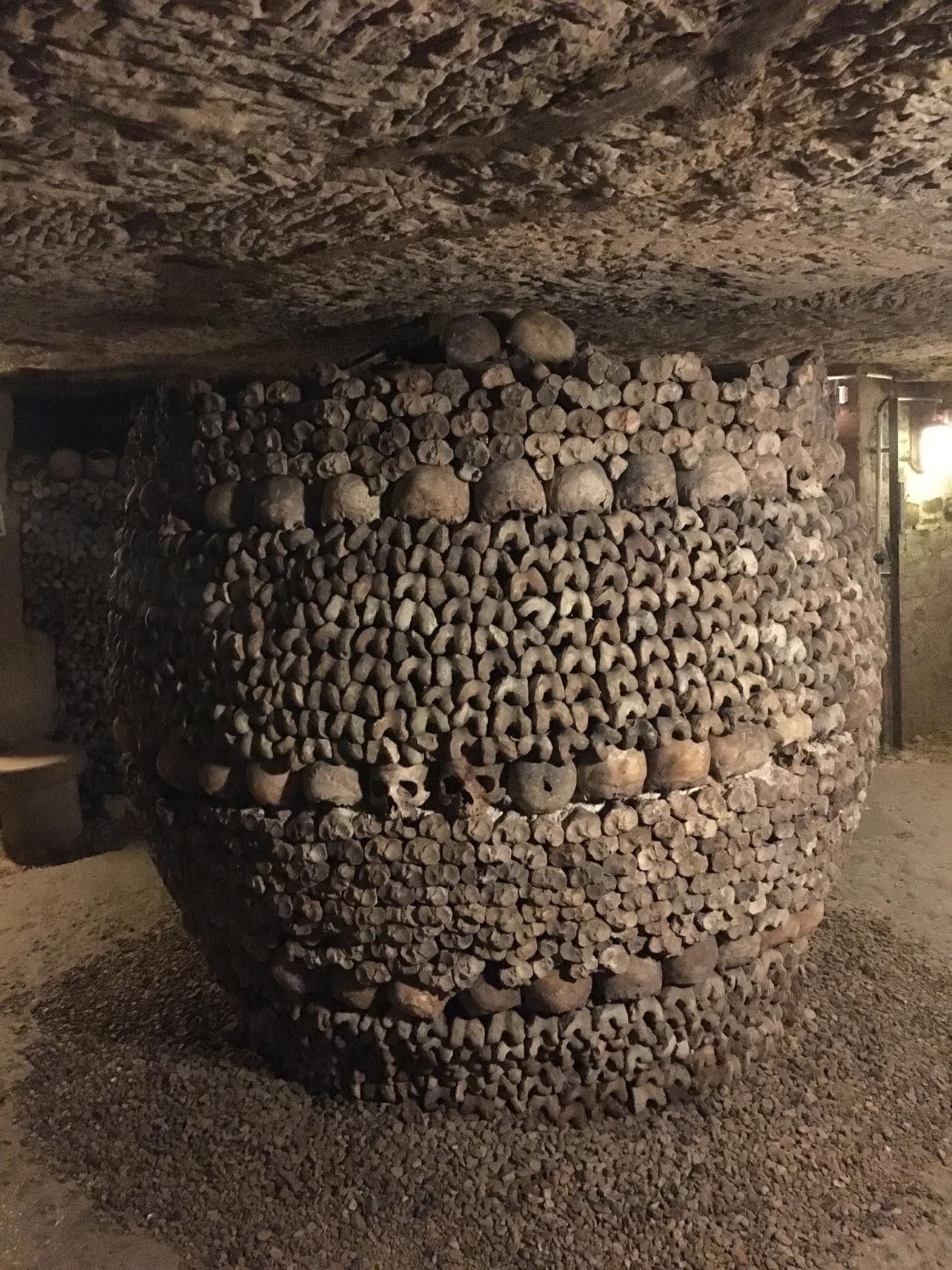
Relevant Information
Opened Tuesday to Sunday – 9:45am – 8:30pm
Online tickets must be purchased prior to your visit:
Did you miss Part 1 of Paris Month?
You can take a look here:
https://paragraph.xyz/@savvytravelhistorian/traveling-through-history-issue9

Michelle is a speaker, author, content marketer, historian and mother of 3 boys.
After 25 years in business and as the ‘Content Marketing Queen’ for the past 12 years, she has helped countless small businesses understand and develop their content strategies and focus on a customer first approach.
Savvy Travel Historian is her passion project, and her weekly newsletter is available on Substack, Paragraph and Mirror. The latter two allows you to collect each Issue as an NFT.
Michelle is co-host of the Web3 By Three Podcast, a weekly show which talks about current stories in the Web3 space and how it applies to B2B marketing, sales and operations. The show is recorded live every Wednesday at 4pm EST/ 9pm UTC on LinkedIn, YouTube & Twitter Spaces.
You can follow Michelle in these places:
Savvy Travel Historian Instagram
Content Marketing Queen Website

